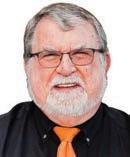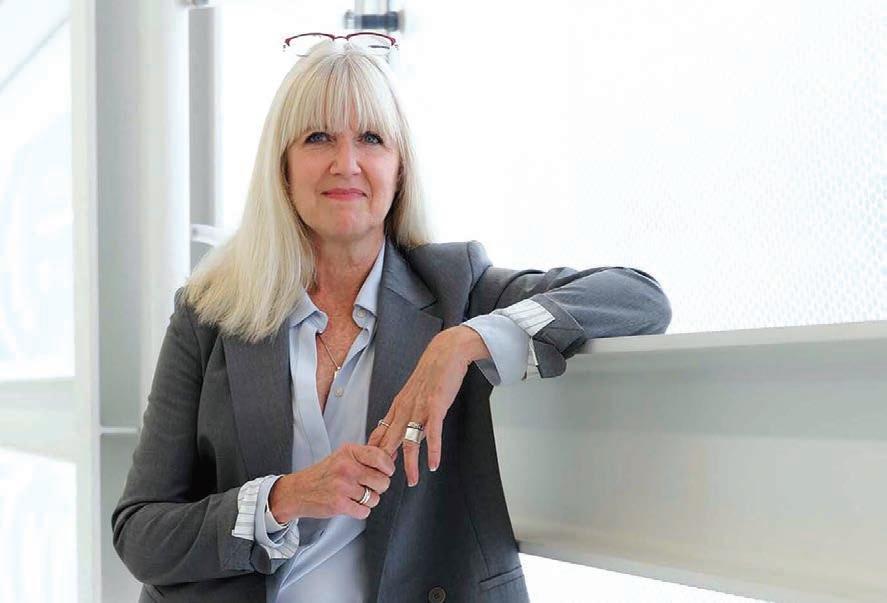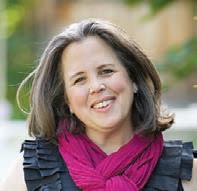




Newly released data shows the Cook County assessor is bullish on hotels and takes a relatively rosy view of retail and of ce space on the corridor I
Magni cent Mile hotels have recovered all of their lost value from the COVID-19 pandemic and then some, if you ask Cook County Assessor Fritz Kaegi. at's probably hard to buy for hoteliers along one of the city's biggest tourist destinations.
At the InterContinental Chicago hotel at 505 N. Michigan Ave., a comeback from
the pain of the public health crisis has pushed the 45-story building's assessed value to $96.2 million, newly released assessment data shows. at's a whopping 284% higher than the property's nal assessed value last year after the owner of the 792-room inn appealed to the Cook County Board of Review.
Just up the street, the 347-room Omni
By Danny Ecker
Chicago was assessed at about $51.1 million, a 186% increase from where the appeals board pegged it in 2023, county data shows. ose valuation leaps and similar tripledigit percentage ones for the Warwick Allerton, Park Hyatt Chicago and Peninsula Chicago hotels along North Michigan
See MAG MILE on Page 23

Overall, the total assessed value for properties in North Chicago Township rose 30%, according to a news release from the assessor’s of ce.
The school faced a turbulent year with the resignation of its president and staff layoffs to address a $38M budget de cit


By Brandon Dupré
After a turbulent year for Columbia College Chicago, which saw its president resign amid a mounting budget de cit and the school lay o 70 employees and cut programs, the arts school recorded its lowest freshman enrollment in recent memory.
e school reported 959 new enrolled freshmen for fall 2024, a 40% decrease from just a year ago and a 55% drop from its freshman enrollment over a decade ago. e school told Crain’s it was its lowest freshman enrollment in the last 15
DAN MCGRATH
Jerry Reinsdorf has threatened to move the White Sox before. This is different. PAGE 2

years, but could not provide further historical context beyond that.
“I think we took reputational damage this last year,” said the school’s chief of sta , Laurent Pernot. He said that damage may have contributed to the large drop in enrolled freshmen this year.
e enrollment gures are salt in the wounds for a private arts college that is coming o one of its most turbulent academic years in recent memory and has work to do to close a $38 million de cit for
See COLUMBIA on Page 23
At UChicago, new Nobel Prize adds a touch of irony to an old dispute.
PAGE 3

Reinsdorf has threatened to move the White Sox before. is is di erent.

Aword of caution to those disgruntled patrons who a xed Bozo noses to Jerry Reinsdorf’s picture and implored the beleaguered chairman to sell the White Sox during the most futile season in franchise history: Be careful what you wish for.
Reinsdorf just might do it.
And for those who complain about the inconvenience of traveling to Bridgeport to watch baseball, try Nashville. It’s a lot farther south, and a much more expensive trip.
I know, leveraging another city against his current city is in the Reinsdorf playbook. It worked for him in 1988 — hello, St. Petersburg — and got him the new ballpark he was demanding, though not in the location he wanted, which is among the reasons he has cited in seeking a replacement home for his 33-year-old current home, which seems just ne by most folks’ standards.
A typical South Side bungalow is barely broken in at age 33, but Reinsdorf never seemed to have much a nity for South Side norms and traditions.
Gov. JB Pritzker comes down on the side of Guaranteed Rate Field being adequate, because the idea of public nancing for a new Sox yard has thus far been a political nonstarter.
So the Nashville talk may be Reinsdorf’s way of getting the governor’s attention.
But even if Pritzker were to change course on public funding, the Bears would beat the White Sox to the front of the line. They are, after all, the Bears, and their 4-2 start has touched off citywide euphoria — will Caleb Williams run for mayor?
e Sox? In the best of times, they’re probably No. 4 among ve in the major pro sports’ local pecking order. It would require an awfully depraved sense of humor to describe these as the best of times, on the eld or at the gate.
e fans would not be so angry if there were signs of life — a prospect on a par with the Brewers’ 20-year-old Jackson Chourio, say, or a pitcher who deals in the manner of a young Chris Sale — but the team the White Sox ran out there this year might have been middle of the pack in the Double-A Texas League.
And after a buildingwide search, the rebuild has been
entrusted to a front-o ce neophyte who had a hand in assembling the worst team in franchise history, which is why the chairman’s baseball acumen is under re. e Sox are a distressed property, alright. But there’s somebody out there who will pay $2 billion to buy and try to x them.
Regardless of whether former Oakland A’s ace Dave Stewart has access to that kind of scratch, there are folks in Nashville who do, so the Music City’s role in this can’t be discounted. Football and hockey are thriving there — the NHL's Predators sell out every game, and the NFL's Titans draw more than 64,000 with a bad team.
MLB might want a team in Nashville without the hassle of expansion — it’s a more viable baseball market than Las Vegas, where the A’s seem headed. And Stewart would be the rst Black owner in a sport still trying to rectify an abysmal history of race relations.
The late Illinois Gov. Jim Thompson is remembered still for a “stop the clock” maneuver to get legislation passed that got the “New Comiskey” built and saved the White Sox for the South Side when St. Petersburg beckoned in 1988.
Similar intrigue had occurred 13 years earlier. With the franchise oundering and the ballpark collapsing, Commissioner Bowie Kuhn sought to transfer the White Sox to Seattle to settle a lawsuit city leaders had led over the mysterious means by which the Pilots were allowed to leave for Milwaukee and become the Brewers after one underfunded, tumultuous season in the Paci c Northwest.
Native son Andy McKenna decided the South Side would be irreparably harmed by the loss of its ball team, so he rounded up enough investors to buy the Sox from John Allyn. He then traveled to Maryland and coaxed Bill Veeck out of a comfortable retirement to run the baseball side and, much to Kuhn’s dismay, the White Sox have been here ever since.
After five madcap seasons, poor health and poor financing at the dawn of free agency forced Veeck out. Kuhn exacted revenge by dismissing Edward DeBartolo Sr. as a prospective buyer, and Jerry Reinsdorf’s group got the team, for better or worse.
It’s going to take an individual with Andy McKenna’s passion and resolve to keep the operation local if Reinsdorf decides to sell.
Passion, resolve and much deeper pockets.
By Brandon Dupré
e Alinea Group, the team behind Michelin-starred restaurant Alinea, has named its rst CEO — a tech entrepreneur who's relatively new to the industry.
Jason Weingarten, an entrepreneur behind startups like recruitment platform Yello and venturecapital rm Subconscious Ventures, becomes Alinea Group’s rst CEO after buying out Nick Kokonas, the longtime co-owner and founder of the group who will remain a minority investor.
e deal, which was not disclosed, is the rst big leadership change for Alinea Group since it launched in 2005. Co-founder and executive chef Grant Achatz remains with the group.
Coy on immediate plans, the new CEO said he'd like to “leverage the intellectual property” and name brand of the group while continuing to make “magical dining experiences,” a key feature he believes sets the restaurant group apart.
“I think there's a lot of opportunities that will come our way, and my job is to create the right shelter and make sure that we can continue to execute at the level of excellence that this organization has for 19 years,” Weingarten said in an interview with Crain’s.
He did mention some potential ideas. One would be spinning o one of Next Restaurant’s dozens of proven menus into its own restaurant. And e Aviary, one of Alinea Group’s bar ventures, has been oated as a possibility to bring to di erent locations, even out of state, Weingarten said.
Another option could be similar to what Achatz teased on his

Instagram account: a collaboration with existing Chicago brands, such as e Wieners Circle.
"Bringing Jason on board o ers a fresh perspective and energy, which is key as we move forward," Achatz said. "We’re not looking to expand for the sake of expansion, but rather to ensure that any growth aligns with the values that have always de ned e Alinea Group."
While relatively new to the food space, Weingarten is not a novice. He launched the meal-kit company Entree in 2022 and recently opened South Loop eatery Oliver’s, which is led by chef Alex Carnovale — an alum of nedining restaurant e French Laundry — and is inspired by the vibes of old Hollywood, “where supper clubs were the epitome of elegance and timeless charm,” according to its website.
Weingarten said there is no plan to fold Oliver’s into Alinea Group.
One of the things he is most excited about: working with Achatz, which he likened to playing with Michael Jordan in the '90s.
“If I was a basketball player, and you’re like, ‘Would you like to play with Jordan?' Yes, sign me up!” he said. “It's not lost on me that (Achatz) may be the greatest in his generation and I get to partner with him — I'm just beyond thrilled and honored that he wanted to work with me, too.” Achatz and Kokonas founded Alinea in 2005, putting the group on the map as one of Chicago’s premier dining destinations. In 2010, it earned a three-star rating from Michelin and remained the city’s lone restaurant to achieve such a feat for over a decade. e Alinea Group has since opened ve other establishments, according to its website, including two bars as well as restaurants Roister and the Michelin-starred Next.


“It’s the partnership that matters.”
BART VITTORI – CHIEF FINANCIAL OFFICER | MEATS BY LINZ


The Pearson Institute — whose chief won the prize — hasn’t met expectations, say the sponsors who donated $100M to launch it
By Steven R. Strahler
In a long-running court battle, the family foundation behind the establishment of e Pearson Institute for the Study & Resolution of Global Con icts has sued the University of Chicago. It wants its money back after complaining that the institute has squandered some of those funds and didn't hire suciently quali ed faculty members.

It also has an issue with who was — or wasn't — appointed to run the institute and how the selection process was conducted. As it happens, the institute director, James Robinson, was awarded the Nobel Prize in economics earlier this month.
While there is no guaranteed connection between academic brilliance and leadership or managerial talent, the news added a touch of irony to the litigation, which has been grinding on for nearly seven years, with 400some docket entries, in an Oklahoma federal courthouse.
Robinson, the Rev. Richard L. Pearson professor of global conict studies, isn't the only Nobel laureate on the four-person Pearson faculty. Roger Myerson won the same prize — technically a bank-sponsored Prize in Economic Sciences in memory of Alfred Nobel — in 2007. at
makes fully half of Pearson's faculty Nobel-certi ed. e omas L. Pearson & e Pearson Family Members Foundation, led by brothers omas and Timothy Pearson, pledged $100 million in 2015 to get the institute going but then sued three years later to sever the arrangement and recover the $22.9 million it had already forked over.
In June, the university won a partial summary judgment, and this month the judge set the case for jury trial, writing that "the parties currently believe the prospects for settlement of this case are poor" after engaging in mediation e orts in 2017 and 2021.
In an allegation that sounds more suited for Chicago's City Hall than Hyde Park's ivory tower, the foundation contends that "the university engaged in a persistent pattern of nepotism, using the foundation’s monies or the Pearson Fund as well as (institute) opportunities to bene t relatives, colleagues, o cers, directors or friends of the university," according to court lings. e university has denied the allegations and led a counterclaim seeking to hold the foundation to its pledge. A spokeswoman
See UCHICAGO on Page 21

Two years after village of cials pivoted from trying to stop demolitions toward offering incentives for keeping an old house standing, the approach seems to have slowed the wave I
By Dennis Rodkin
Two years after rolling out a package of incentives aimed at slowing the tide of teardowns, Hinsdale preservationists saw the fruit of their e ort Oct. 14, when the new owners of a 1930s colonial once slated for demolition came to collect.
The application by the homeowners, who aren’t named in public records, for zoning variances, fast-tracked permits and property tax rebates to facilitate putting an addition on the back “shows we’re turning the corner on teardowns in Hinsdale, finally,” says John Bohnen. He’s a member of the Historic Preservation Commission and one of the leaders in the 2022 pivot toward incentives designed to save old homes.
See HINSDALE on Page 21
By 2022, one out of every four houses in Hinsdale had been torn down and replaced since the dawn of the 21st century.
Corporate travel is crucial to United Airlines and its hometown hub, O’Hare Airport. But the coasts are seeing the biggest increases.
By John Pletz
United Airlines says the longawaited rebound in business travel has kicked in.
Business tra c in the third quarter overall was up 6% year over year but grew twice as fast in September, said Andrew Nocella, the company’s chief commercial o cer.
“We see corporate tra c accelerating. at’s United’s bread and butter. We’ve been waiting for that to happen for a while,” he told analysts during an earnings call on Oct. 16. “Corporate demand acceleration was nice to see in September across all re-
gions and is expected to continue in Q4."
Hybrid work and work-fromhome have weighed on business travel, which rebounded from the COVID pandemic more slowly than leisure travel. That’s had an impact on United as well as O’Hare International Airport.
United has managed to capitalize on premium travelers, despite sluggish business travel, gaining on its rivals. Chicago’s largest airport, however, has recovered slower than some of its peers, and it’s lagging coastal hubs in the rebound in corporate travel.
“United is centered in the largest business markets,” he added. “As corporate demand increases, we expect a material tailwind.”
Nocella said eight of the top 10 biggest post-pandemic corporate-revenue booking days at the airline have occurred since the start of September, including a record-breaking day.
Although United’s contracted revenue with corporate travel departments was up 13% in September, and much better than July and August, it’s still at 95% of what it was in 2019, Nocella said.
“Coastal hubs are stronger

than the interior hubs; professional services, nancial services and tech are growing fastest, where energy and a few other things are growing slow,”
he added. “All verticals are growing, and corporate tra c looks good. e coastal hubs are much stronger than the interior hubs at this point.”
A 185-unit residential building has joined a growing list of distressed properties as landlords grapple
By Danny Ecker
A Gold Coast residential tower has joined a growing list of downtown apartment buildings falling into distress as elevated interest rates keep squeezing landlords.
A venture led by New Yorkbased TPG Angelo Gordon last month transferred the 31-story apartment building at 2 W. Delaware St. to lender Acore Capital, according to Cook County property records. An Acore affiliate had provided a $130 million mortgage backed by the 185-unit property in late 2020 and seized the tower via a deed in lieu of foreclosure, records show, typically a way for a lender to take over a property without a lengthy foreclosure process. It's one of the largest cases of distress in the well-performing downtown apartment market, but it's far from the only one. While much of the distress across the downtown commercial property sector is dominated by o ce properties, owners of multifamily properties have also been hard-pressed to pay o maturing debt because borrowing costs have spiked over the past 2½ years. Rent growth in Chicago's urban core has also slowed over the past several quarters, adding to the challenge for apartment owners that need to re nance.
e owners of apartment buildings at 1407 S. Michigan Ave., 860 N. DeWitt Ave. and 63 E. Lake St. are among those that
have either been hit with foreclosure lawsuits this year or lost properties to their lenders.
It's unclear what prompted the TPG Angelo Gordon venture to surrender the Delaware Street property, and a spokesman for TPG Angelo Gordon declined to comment.
e TPG Angelo Gordon entity paid nearly $135 million in 2016 for the rental portion of the property, which was originally developed in 2010 as a condominium tower called Walton on the Park but turned into mostly rental units after condo demand foundered during the great nancial crisis. When the rm and its partners, Chicagobased JDL Development and Norridge-based real estate rm Harlem Irving, bought the unsold condos, JDL said it intended to return the property to its original state and sell o condo units again.
But after selling just nine units over the ensuing 18 months, the owners pivoted back to rental units to take advantage of a strong downtown apartment market. at plan helped boost the property's value enough that the group was able to capitalize by re nancing the rental portion of the tower with the $130 million mortgage toward the end of 2020.
JDL CEO Jim Letchinger said his rm was brought in to oversee the conversion to rental units, but has had "no nancial obligations" to the property for the past few years.
A Harlem Irving spokesman

didn't respond to a request for comment.
It's unclear what Acore has planned for the property, and a spokesman for the lender declined to comment.
e Real Deal Chicago rst reported that Acore had taken control of the property.
Net monthly rent at top-tier, or Class A, apartment buildings downtown was $3.75 per square foot midway through the year, according to data from appraisal and consulting rm Integra Realty Resources. While that was
still close to an all-time high for the market, it was a hair below the same time in 2023. A rush of new projects being completed — downtown is on track to have more new units delivered this year than any year since 2017, according to Integra — has weighed down rent growth.
Still, apartment landlords are expected to gain some pricing power next year. A drop-o in new construction projects getting nanced and underway during the COVID-19 pandemic has lined up a 2025 in which the
market will see little new supply.
TPG Angelo Gordon has a big portfolio of Chicago-area commercial real estate, primarily in the industrial property sector. JDL is a longtime developer downtown, known recently for leading the development of the 76-story One Chicago Square mixed-use residential project in River North, among other projects.
Harlem Irving owns a portfolio that mostly includes retail and mixed-use apartment properties in the Chicago area.
United Airlines’ CEO says the clouds will soon part for the encumbered aircraft-maker
By John Pletz
United CEO Scott Kirby sees the clouds eventually breaking for Boeing, which not only is a former corporate sibling of the Chicago-based airline but remains a crucial business partner.
Boeing has suffered through a seemingly unending string of problems that began with two fatal crashes of the 737 Max six years ago, included two CEO changes, and currently is dealing with a strike by 33,000 workers. All of which has meant a lot of turbulence for customers like United.
“What I care about with Boeing is the long term,” Kirby told analysts yesterday during United’s third-quarter earnings call. “And I am actually encouraged
with Boeing.
“(Boeing has) a cultural challenge where they focused on short-term profitability and the short-term stock price at the expense of what made Boeing great, which is: building great products, great engineering, great quality, reliability, safety that you can count on. And I think (CEO) Kelly Ortberg is pivoting the company back to their roots. I think all the employees of Boeing will rally around that.”
Boeing’s manufacturing delays, which include pushing out the release of new variations of the 737 that United and Southwest Airlines have been counting on as part of their own business plans, have caused plenty of aggravation.
United has turned to Airbus

to fill in some of the gap, but its fleet is still weighted toward Boeing.
In the third quarter, for exam-
ple, United took delivery of 17 Boeing Max aircraft and three Airbus A321neo aircraft. And both plane-makers still
are struggling with delays that have reduced output.
Kirby said he's encouraged by reports that Boeing is looking to raise $15 billion in capital.
“To me, the biggest news in the last couple of decades really at Boeing is the willingness — reported willingness — to sell equity,” he said. “ at's making the right long-term decision regardless of what (Wall Street) thinks about it in the short term. So I applaud them for doing that, as a long-term customer. It's the right thing to do for their shareholders long term also. And so I'm encouraged with the changes that they're making." e labor woes, he says, are more of a short-term problem. “ e strike is, in a lot of ways, a cultural legacy of the same issues that have happened over the past couple of decades,” he said. “It's tough, but they will get through it. I'm con dent they will.”
























XOchimilco is leading a charge to make sure its side of the street is dry no more, with a measure that will appear on ballots for some Lincoln Square residents next month. It’s a matter of survival for the eatery, a co-owner says. I By Ally
AMexican restaurant is pushing to overturn a ban on alcohol sales that has been in place in Lincoln Square for more than 100 years.
e ban covers about three blocks, from Lincoln Avenue on the west to Damen Avenue on the east, Sunnyside Avenue to the north and Montrose Avenue to the south. at area comprises the 9th Precinct of Chicago’s 47th Ward. It has been dry since 1907, more than a decade before Prohibition took hold of the country.
XOchimilco, a restaurant at 2030 W. Montrose Ave., is leading a charge to make sure its side of the street is dry no more. A measure will appear this November on the ballots of the less than 500 residents who live in the precinct’s three-block radius. e measure asks if the liquor prohibition should be continued. “No” votes from 51% of voters will overturn the ban.
Getting those “no” votes is a matter of survival for XOchimilco, said Lucia Herrejon, who owns the restaurant with her husband, Epifanio Benitez. e two opened the Mexican restaurant in 2018 as a bring-your-ownbeverage spot. But after the COVID pandemic, XOchimilco needed another revenue stream and Herrejon decided to apply for a liquor license.
Like other restaurants, XOchimilco abided by mandated COVID shutdowns, then was hit with the in ation that followed. e cost of eating out nationwide has gone up about 30% since 2019, according to a Crain’s analysis of consumer price index data. Restaurants, which already operate on razor-thin margins, saw their pro t margins shrink further.
XOchimilco has increased its menu prices several times since the pandemic to help o set in ation. Selling alcoholic beverages — which typically yield higher pro t margins in a restaurant than food — could stave o this year’s price increase, Herrejon said. It would also help the restaurant make enough money during its busy season to get through slower months like September and October, when everyone goes back to school and business drops o .
“We need to make sure we have saved some money to be able to make it through those two hard months,” Herrejon said. “Our sta has a family and they need that steady check.”
e ban was put into place in 1907. A group of brewers from St. Louis — led by Adolphus Busch — had plans to build an amusement park near the cur-


rent location of Welles Park. It would be called Tyrolean Alps, and was meant to mirror the German countryside and introduce Americans to the region’s beauty. Plans included a beer garden, which would appeal to the waves of German immigrants who had arrived in Chicago in the previous decades.
Another amusement park had recently opened less than two
miles away, at Belmont and Western avenues along the Chicago River. Newspaper reports at the time show that nearby residents led complaints about Riverview Park, as it was called. Music and dancing stretched into the night. Chrissy Cogswell, a librarian at Northeastern Illinois University who did research on the dry precinct in Lincoln Square for her graduate studies,
said that residents near Welles Park would have been aware of the reported amusement park ruckus and wanted to keep it out of their own neighborhood.
Meanwhile, the temperance movement, which sought to limit drinking, was in full swing. Cogswell argues there were other issues at play, too. e area had recently been annexed into Chicago, and while that gave resi-
Marotti
dents access to needed city services, it also brought increased accessibility — including to the many immigrants arriving to the city. A uent communities throughout the country were using the temperance movement to keep certain populations away, Cogswell said. She argues the folks who pushed for the alcohol ban near Welles Park were doing the same.
“ ese aren’t necessarily people that were like, ‘Oh, I support temperance or I support Prohibition,’ ” she said. “ ese are more opportunistic usages of this popular temperance thing basically as a way to stop their neighborhood from changing.”
e residents engaged their aldermen and ultimately passed a ban on alcohol for the three blocks to the east of Welles Park, e ectively keeping Busch and his fellow brewers at bay.
More than a century later, and the alcohol ban is still shaping the makeup of businesses in the neighborhood.
One of Lincoln Square’s main commerce strips runs along Lincoln Avenue. It is full of restaurants, cocktail bars and even a bookstore that sells alcoholic beverages. However, the number of restaurants in the three blocks under the ban can almost be counted on one hand.
“ ese kinds of hurdles will affect a business’ interest in an area,” said Rudy Flores, president and CEO of the Lincoln Square Ravenswood Chamber of Commerce. “As a small-business owner, why would I want to go after that property when I can nd somewhere else in the city that would be easier for me?” e ban has also caused confusion for potential diners and businesses alike. People don’t understand why a restaurant on one side of the road can serve wine or cocktails while a place just across the street cannot. Herrejon said customers regularly leave when they nd out they can’t order a margarita with their dinner.
Small Cheval, a burger restaurant owned by Chicago-based Hogsalt Hospitality, is planning to open in the area a ected by the ban. A representative from Hogsalt did not respond to a request for comment, but public o cials said management has expressed concern over the prohibition on alcohol sales.
“Being able to lift this would allow our existing businesses to do better while incentivizing prospective businesses to give a closer look to this stretch,” said Ald. Matt Martin, 47th. “It has the opportunity to really ll in some gaps.”
Accuride is trying to rid itself of an unpro table contract with the automaker and, in the process, of oad one of the oldest manufacturers in Illinois
By Kurt Nagl, Crain's Detroit Business
Accuride Corp., a Michiganbased supplier of wheels for semitrucks and light vehicles, has led for bankruptcy with $486 million of debt as it seeks to exit an unpro table General Motors contract and dump one of the oldest manufacturers in northwest Illinois in the process.
Accuride and its subsidiaries in the U.S. and Canada petitioned for voluntary Chapter 11 bankruptcy protection earlier this month in the District of Delaware and restructuring in Canada, aiming to shed debt and money-losing business.
e company, whose board chairman, Jason Luo, has plenty of bankruptcy experience, wants out of its contract to supply wheels for GM’s BrightDrop electric vans in Ontario.
e automaker is unwilling to renegotiate terms, said Grant Hatton, director of marketing for Accuride. About 75 percent of its business at the Ontario plant is with GM.
“So, with the cost of materials and labor rising due to COVID-19 and in ation, it has basically made that contract unpro table for us,” Hatton said.
Underutilization of plants and softening demand, particularly in the freight truck industry, also drove Accuride to seek bankruptcy reorganization, Hatton said. Manufacturers of heavy-duty trucks are its primary customers in North America.
e company, which is based in Livonia, Mich., a Detroit suburb, is looking to o oad its Gunite Corp. business in Rockford, Ill., which produces brake drums, hubs and rotors for medium- and heavyduty trucks. Hatton said the Gunite business — founded in 1854 and said to be the longest continuously running manufacturer in town — can no longer be run pro tably.
“We have a more diverse customer base coming out of that location, but it's pricing, demand and aging infrastructure,” Hatton said. “It's a 175-year-old plant. is is a pre-Civil War location…. ere’s increasing costs of capital
investment and maintenance.”
A GM spokesman said operations are not impacted and that the company would not comment on negotiations with suppliers.
e company is continuing North America operations as usual through the bankruptcy under debtors in possession, according to the bankruptcy ling. Lenders agreed to provide $30 million in new money term loans to fund operations until the company emerges from bankruptcy, which it anticipates will be 90-100 days.
e company’s business in Mexico, Asia and Europe are not part of the bankruptcy. Accuride employs 3,600 globally.
It is owned by New York Citybased private equity rm Crestview Partners, where Luo serves as an operating executive.
Luo is the former CEO of Key Safety Solutions who oversaw a monthlong bid to buy troubled airbag supplier Takata Corp. out of bankruptcy in 2018. Takata's defective airbags triggered the largest recall in global automotive history and were linked to nearly 30 fatalities.
Luo last made headlines in 2022 when EV delivery van startup Electric Last Mile Solutions led for Chapter 7 bankruptcy liquidation. Luo, a co-owner, and James Taylor, former president and CEO, were forced out of the company after an investigation found they improperly purchased equity in Electric Last Mile before it went public though a SPAC merger.
Accuride has between 1,000 and 5,000 creditors, according to its bankruptcy ling, which lists assets between $500 million and $1 billion.
Its largest unsecured claims are Brampton, Ontario-based Matalco Inc., owed $22.8 million; Chinabased Zhumadian Cimc Huajun Casting Co., owed $12.6 million; and China-based Trailer Master Cvs Inc., owed $7.2 million.
e largest unsecured claim in Michigan is to Jackson-based C. orrez Industries Inc., owed just over $1 million.
Kurt

Don't
industry-specific productivity updates, and important opportunities and ideas to enhance growth.
Wednesday, November 20 | 7:15 to
University Club of
76 E. Monroe Street Cathedral Hall - 9th Floor

Jeff Korzenik, Chief Economist Fifth Third Commercial Bank

Gerald Cohen, Chief Economist UNC Kenan Institute of Private Enterprise
Jim Kirk, Group Publisher, Crain’s Chicago Business






For decades, McDonald's has maintained a sterling reputation for food safety — so much so that when news broke that an outbreak of E. coli had sickened some McDonald's customers and killed one, a food science professor at Rutgers University told Bloomberg, "My jaw dropped."
In general, the Chicago-based burger giant has won decent marks from marketing experts and PR analysts for coming clean about the incident and revealing the suspected source: raw onions served on the chain's Quarter Pounders. McDonald's moved swiftly to notify the public, pull Quarter Pounders from its menus and eliminate onions from its o erings for the time being until the true source of the outbreak could be known. Out of an abundance of caution, other restaurants, from Burger King to Taco Bell, are also holding the onions, so to speak, until everyone gets the all-clear. McDonald's followed up on the news with a YouTube video featuring Joe Erlinger, president of McDonald's USA, who emphasized to consumers that other burgers on the menu were not a ected.
So far, so good. But there's a lot more that McDonald's can and should do to right the ship, not only for the safety of its customers but for the con dence of its employees and investors as well as the

long-term health of its brand.
For one thing, PR experts interviewed by Crain's sister brand Ad Age note that the chain should be more proactive by addressing food safety in its marketing and using social media channels beyond YouTube to drive the message home. Similarly, many recommend that leadership should now turn its attention from information to empathy. " ey have to take care of the impacted
The unprecedented mass resignation by the Chicago Board of Education and the mayor’s news conference to follow crystalized a crisis of governing and leadership in our city.
Despite Mayor Brandon Johnson claiming he has led “a collaborative operation” since taking o ce, it has been anything but, with this stunning development only the latest in an unfortunate trend.
It’s a course we can correct if we understand how we got here and work together to move forward more productively.

Bill Conway serves as alderman of Chicago’s 34th Ward and as an intelligence o cer in the U.S. Navy Reserves.
In roughly the last month alone, the mayor pushed out his Intergovernmental A airs team and replaced them with two sta members who have said unprintable things about the police and the Holocaust; asked an ostensibly e ective Chicago Public Schools CEO to resign for refusing to take out an irresponsible high-interest, short-term loan; and then ousted the entire Board of Education (that he appointed) in the middle of contract negotiations for refusing to do the same.
force if it had come from Kempczinski. e CEO hasn't been shy about expressing his viewpoint before — so much so that back in 2021, he made remarks about a shooting at a Chicago McDonald's restaurant that forced him to go on a South Side listening tour to learn why his comments were viewed by many as racially insensitive. On the plus side of that misstep, however, was this: Kempczinski put himself at center stage in the crisis communications cleanup e ort, showed some humanity and appeared to learn from his mistakes.
customers nancially, yes, but emotionally too," said one expert. "Personal calls from corporate leadership and franchisees to those hurt can help humanize the brand."
And that's where CEO Chris Kempczinski has an opportunity to step into the spotlight in a way he has not done until now. e YouTube message from Erlinger, the U.S. chief, was more or less ne, but it would have had much more
In the current situation, with the company's stock taking a hit, the inevitable conga line of lawsuits already starting, and many consumers shying away from eating at McDonald's as the crisis expands with at least 75 people sickened in 13 states, people want to hear from the CEO. What they want to hear isn't merely a recitation of the cause of the outbreak and the steps being taken to prevent a repeat — they want to hear an acknowledgment or apology to those who were sickened by eating McDonald's food. As Bloomberg Opinion columnist Beth Kowitt points out, the silence on this front is likely the work of McDonald's legal department. But if Kempczinski & Co. want to persuade customers it's safe to eat at the Golden Arches again, empathy has to be part of the recipe.
he has power, but can he listen?
Johnson says the people of Chicago elected him to use his power unabashedly. He neglects to acknowledge that the people of Chicago also elected their representative on the City Council, a majority of whom support replacing leadership at the Chicago Transit Authority, restoring lifesaving ShotSpotter technology, and taking a more democratic and transparent approach to the fourth-largest school district in the country.
When the mayor dismisses legitimate questions about the Board of Education with, "Council can hold as many hearings as they want," he’s telling the vast majority of this city that their voices don't matter.
His de ance elicits strong opposition from the City Council, including many of his progressive allies: 41 of 50 alders rebuked him for pushing out the school board, and 34 rejected his unilateral cancelation of ShotSpotter.
In the wake of overwhelming opposition, digging in further is not the answer — unless you’re only speaking to the dwindling
few still standing with you in isolation.
All of this would be troubling alone, but it’s increasingly urgent as we head into budget negotiations with the city facing a $1 billion shortfall. Unfortunately, Johnson has delayed this year’s process, leaving the council with less time to thoroughly review the numbers and consider innovative solutions that don’t place the burden of balancing the budget on any speci c group or agency.
We must work together in good faith, but it's di cult to navigate our massivenancial de cit amid a de cit of trust. For example, the mayor rst dismissed CPS resignations as mere "rumors," only for the entire board to step down days later. Initially, the hiring freeze didn’t apply to police o cers, and now it does, with two academy classes for incoming o cers canceled. Inconsistency erodes credibility.
I don’t o er this feedback re exively or politically. I supported the mayor’s rst budget and the recent bond re nancing — votes that earned me raised eyebrows from some — because I believe they were the right things to do. I’ve also spoken up when I disagree, such as with certain police settlements that exceeded precedent and these recent events. I believe that gov-
erning requires us to listen to each other’s concerns and principles, not obstruct a reasonable process or retreat to our respective corners.
Johnson was elected by a diverse coalition of Chicagoans to unite us in a shared vision for success, but he is not facing our city’s challenges alone.
Each member of the City Council brings unique experience to the table. As vice chair of the Finance Committee and someone who led debt o erings while working at J.P. Morgan and now teaches nance at DePaul University, I stand ready to help address this complex crisis — along with many of my colleagues. I hope he will lean on our collective expertise. While the mayor didn’t create Chicago’s nancial crisis — previous administrations have kicked the can down the road for too long — as he points out, he “has the power.” I encourage him to use that power to bring people together and develop real solutions rather than perpetuating this cycle that burdens future generations with billions in debt.
If Johnson is ready to collaborate, he’ll nd an eager coalition to support him. After all, the city thrives when the mayor succeeds.
An elected school board for Chicago is one of those ideas that sounds a lot better than it likely is going to be.

Even Mayor Brandon Johnson, who ran on a promise to get this done, had second thoughts as the deadline for electing the full 21-member board approached. Johnson worked with allies in Spring eld to slow the roll a bit. Now we are poised to vote for only 10 board members; Johnson will appoint 11, including the president. We'll have a fully elected board in 2027. Ever since the mayor of Chicago was given control over the board in 1995, I've been in favor of the accountability it promises voters. Now, if Johnson's decision to play musical chairs with his handpicked board doesn't bring stability to our schools, voters will surely hold him accountable. When the music stops, Johnson could be the one without a seat.
But a 21-member board? Anyone who has managed a board for a nonpro t or corporation will know this is a red ag.
And Chicago Public Schoolswatchers know it, too. In the early 1990s, when the so-called "United Nations board" numbered only 15, they would grandstand at every meeting on behalf of their (narrow) constituency. Latinx members focused on overcrowded Northwest Side schools. A Muslim member took every opportunity to argue that pork shouldn't be served in school cafeterias. Black board members fought for the equity that still alludes many of their communities. All were critical issues to address. But with board members often making their case as tangents to unrelated agenda items, they only decreased their e ectiveness.
So how will our newly elected and appointed board members work together as a team focused on stabilizing nances and improving outcomes for all students? I'd say it's up to us, the voters, but that's not exactly how these races are shaping up.
Crain's columnist Greg Hinz and other local media are providing extensive information about candidates and their positions. is coverage suggests the best way to choose who gets your vote is to follow the money.
In nearly all districts, our choices are warped by money dropping on two kinds of candidates. On the one hand, we have the Our Schools Coalition, working for Chicago Teachers Unionbacked candidates pledging to support fully funded, sustainable schools. On the other, we have the conservative-driven movement to replace public schools
with charters, led by the Illinois Policy Institute and the Illinois Network of Charter Schools' super PAC, funded by billionaires and others who don't live here, including Palos Heights resident Paul Vallas, who lost the mayoral race to Johnson. ey back candidates with a commitment to using public school dollars to support private schools by expanding charters and using a voucher system repeatedly proven to destabilize public schools. If you're nonetheless tempted by their arguments, consider the
charter network Acero's abrupt announcement of plans to close seven schools in June, taking by surprise more than 2,000 students in such underserved communities as Pilsen and South Lawndale.
Flirting with a third candidate? Proceed cautiously. Just as in the current presidential race, if you reject candidates drawing big money on either side, throwing your support behind a third candidate might well be a wasted vote. Better to pick a lane.
For my part, I'm strongly op-
posed to the charter school lobby as an e ort to serve private school families and not communities. I will cast my vote to oppose their e orts to control this board. While I'm uncomfortable with the CTU's current hold on the mayor's o ce, I'm not using a broad brush to disqualify CTUbacked candidates. Teachers are front-line workers, and my gut says to trust them. As a parent of CPS graduates, wife of a retired CPS teacher, mother of a current CPS teacher and a longtime public-school activist, I am banking
on teachers who best understand how to improve schools in all neighborhoods. Research backs their push for more social services to support school communities. Despite the clumsy appeal for these changes advanced by both the union and the mayor, I think they're 100% on the money when they insist funding must be found to provide quality education in all schools.
I'll stand with the CTU candidate in my district, and hope others looking to stabilize our schools will do the same.

By
Rivian is locked in a legal fight with the world’s largest automotive supplier over motors in the R1 pickup truck and SUV as the electric vehicle maker grapples with ongoing production issues.
Bosch, whose North American headquarters is in Farmington Hills, Mich., claims Rivian refused to pay $204 million in reimbursements after the automaker axed its e-motor supply deal, brought production in-house and left the supplier with stranded capital and a big hole in revenue.
Rivian accused Bosch of “reckless failures” in its motor supply contract and blamed it for production shortages resulting in 30,000 fewer vehicles manufactured in 2022 than planned. Rivian is based in Irvine, Calif., and has an operation in Plymouth.
The allegations between Rivian and Bosch fly in a legal feud that began in July when the supplier sued Rivian for breach of contract. Rivian responded by filing a lawsuit of its own the same day, also alleging breach of contract and damages of a value to be determined at trial, according to case files in Wayne County Circuit Court.
Meanwhile, Rivian’s e-motor woes continue. Just earlier his month, the company lowered its production forecast for its R1 vehicles and vans due to a shortage of components for inhouse motors, according to the company.
Judge Brian Sullivan scheduled the next status conference for the lawsuit to be Feb. 3 as attorneys undergo the discovery process.
Both Rivian and Bosch issued statements to Crain’s declining to comment on litigation. Attorneys for Bosch, represented by Detroit-based Dykema Gossett PLLC, and Rivian, whose counsel is Detroit-based Honigman LLP, did not respond to requests for comment.
Disputes between automakers and suppliers are common, but rarely do they spill over into lawsuits. The case between Rivian and Bosch offers a window into production issues that have plagued Rivian from the launch of its R1 pickups and SUVs. It also highlights the increasing complexity of the OEM-supplier relationship as automakers race to produce affordable EVs and suppliers vie to contracts to supply their vehicles.
In 2019, Rivian and Bosch signed a development, production and supply agreement for the e-motor — a crucial com -

ponent for EVs that some automakers have sought to control in-house while others have sourced to Tier-1s.
Bosch’s novel quad-motor design was more complex and expensive than other options but offered more power, torque
amortized costs should Rivian cancel the program early,” the lawsuit said.
In September 2023, Rivian canceled the contract after months of silence regarding its future plans for e-motor production, according to the lawsuit.
facturing costs, so it in-sourced the motors, Bosch argues.
“While Rivian’s choice to cut costs and develop a new product may be understandable, Rivian cannot simply ignore its contractual duties to reimburse Bosch…” the lawsuit said.
Disputes between automakers and suppliers are common, but rarely do they spill over into lawsuits. The case between Rivian and Bosch offers a window into production issues that have plagued Rivian from the launch of its R1 pickups and SUVs.
and traction control for the R1 vehicles.
By 2021, after raising $12 billion through an initial public offering, Rivian was focused on ramping up production but was hampered by supply chain issues.
What Bosch says happened
Bosch invested millions of dollars in engineering and tooling at a plant in Germany, where it initially started the production of e-motors for Rivian, according to Bosch’s lawsuit. Additionally, it built a new 30,000-square-foot production line at a plant in South Carolina to accommodate the program.
“Given these signi cant investments and that Rivian was an electric vehicle startup that had never manufactured vehicles before, Rivian contracted to reimburse Bosch for all its un-
Bosch had been contracted to supply 200,000 motors in 2024 and was running its lines at full capacity.
At the same time, Rivian had been designing its own e-motors and drive unit in a system called Enduro, which has just two motors and combines them with the gearbox and power inverter at a signi cant cost savings to the automaker.
Bosch accused Rivian of “secretly” planning to replace all of Bosch’s business with the Enduro system despite telling the supplier it would run parallel with their program or on later generations of vehicles.
According to Bosch, Rivian’s production problems stemmed mainly from a shortage of semiconductors, not e-motor shortages, as the automaker claims in its countersuit. Rivian was losing $30,000 to $40,000 per vehicle and was desperate to trim manu-
how the supply deal turned sour.
“At the very heart of Rivian’s vehicle design were four electric motors,” the automaker’s countersuit said. “To supply these mission-critical, custom motors, Rivian turned to the largest and most established supplier of automotive parts in the world: Bosch… at was a mistake.”
The supplier invested “insufficient resources” and assigned “unqualified personnel” to Rivian’s program, which resulted in the supplier falling dramatically short of volume requirements, the lawsuit said. By the end of 2022, it had supplied just 101,000 motors, or less than half the requirement for the year.
Bosch “choked off” Rivian’s production lines at a crucial point in its ramp-up, causing “cataclysmic” damage to its finances and reputation, the lawsuit said. The EV maker claims Bosch overpromised to many suppliers at once, resulting in its failure to deliver.
“…Bosch made a calculated gamble to overpromise to multiple start-up electric vehicle companies on the theory that at least some of them would soon fail,” the lawsuit said.
As Bosch claimed it tried to help Rivian right the ship at its factory, Rivian claims the opposite is true. On a trip to Bosch’s e-motor plant in Germany, Rivian engineers observed one of the lines “in shambles” and said Bosch “did not use industry standard technology” to monitor its welds, Rivian’s lawsuit said.
“Instead, Bosch had apparently employed teenage interns to stand by the line holding flashlights for quality control,” the lawsuit said.
Bosch contends that while it did hit a manufacturing snag that caused an e-motor bottleneck, it was because of a faulty component — “the A shield” — from a di erent, Rivian-directed supplier.
Bosch repeatedly o ered to send engineers to Rivian’s plants to help with assembly issues, the supplier said in the lawsuit.
“Rivian refused this assistance without explanation, but it is clear that Rivian did not see or treat Bosch as a partner who could help Rivian solve its problems, but rather as a competitor for e-motors and e-axles,” the complaint said.
Now, Bosch’s newly built line in South Carolina is being cleaned and bagged with no alternative use or customer, according to the lawsuit.
Rivian’s point of view
Rivian has a di erent version of
As for claims about shoddy “A-frames” causing the e-motor production problem, Rivian argues shipments had already been delayed before that issue, calling it a “convenient excuse for Bosch’s failure.” Rivian also said it spent “millions” to bring in another A-frame supplier.
The lawsuit cites a letter sent by Patrick Hermann, who was then Rivian’s director of procurement, to Bosch, saying its failure to deliver motors was “the #1 threat to our organization’s success.”
Rivian informed Bosch in September 2023 that it would be ending its e-motor supply deal, opting to take the manufacturing in-house.
“To keep costs down and to place Rivian more in control of its own supply chain, preventing supplier issues from constraining Rivian’s production in the future,” the lawsuit said. Kurt Nagl writes for Crain's sister brand Crain's Detroit Business.

ANDREW SCHMIDT Managing Director
North America
Schmidt manages the North America business of the world’s largest directselling company. He’s passionate about entrepreneurship and helping people live better, healthier lives.
or over 60 years, Amway business owners have been more than just providers of nutrition supplements and well-being products; they’ve been promoters of healthy routines and lifestyles for individuals, families and communities. is enduring commitment is driven by a team of over 800 in-house scientists, engineers and technicians spread across more than 75 labs, all focused on researching and developing innovative products that enhance lives.
At the heart of this mission is Nutrilite.
For more than 90 years, Nutrilite’s rigorous scienti c inquiry and innovative approach have allowed us to continue developing new health supplements that meet quality, safety and e ectiveness standards.
Long before multivitamins became mainstream, Nutrilite introduced Americans to the bene ts of daily health supplements. We stand out as the only global vitamin and dietary supplement brand that grows, harvests and processes plants on our own certi ed organic farms. Our vertically integrated approach means we oversee every step, from seed to supplement, ensuring that
the plants we cultivate on our 6,000 acres of certi ed organic farmland meet unparalleled standards for purity and safety.
For me, the impact of Amway’s innovative products is personal. e Nutrilite Perfect Pack – a combination of vitamins, minerals, plant nutrients
Later this year, we’re thrilled to introduce Begin, a breakthrough product developed by our scientists to enhance gut health and help support the body’s natural defense and overall holistic health.
Begin is just one example of the many nutritional solutions Amway scientists have pioneered to address speci c health needs.
rough enduring relationships and a commitment to continuous care and service, our Independent Business Owners provide an enhanced experience for each customer, helping them lead healthier, happier lives.
and omega-3s – has been part of my daily routine for years. It’s easy to carry and ensures I get the nutritional care my body needs wherever I am. Every morning, I mix Nutrilite Organics Immunity Superfoods, a nutrient-rich blend of acerola cherries, elderberries and other superfruits, into my yogurt, setting a healthy tone for the day.
One of the most exciting areas of research at Amway is our study of microbiomes and their impact on the body’s gut health.
Amway’s Independent Business Owners (IBOs) play a crucial role in delivering our health and well-being products to consumers across America. Trusted by their customers, our IBOs build meaningful relationships and o er tailored health solutions that help individuals achieve their wellness goals.
In New York alone, over 15,000 small business owners engage with their communities, promoting healthy living habits and partnering with us in community engagement initiatives.
Our long-standing partnerships with organizations like Easterseals, support for veterans’ causes and involvement in backpack and coat drives are just a few examples of how we give back.
What truly sets Amway apart is the direct connection to individuals and their communities. rough enduring relationships and a commitment to continuous care and service, our IBOs provide an enhanced experience for each customer, helping them lead healthier, happier lives.
From promoting mental well-being and community involvement to pioneering sustainable practices globally, Amway and its Independent Business Owners are dedicated to empowering people to extend their health span and live their best lives.
For more information about Amway’s business and health & wellness mission and products visit Amway.com/ solutions.




The process of condensing all the complexities of a health care visit into a format that ts in a patient’s residence is a formidable one
By Jon Asplund
Illinois Institute of Technology associate professor Kim Erwin wants to show any health care system in need of a major redesign that it needs a designer at the table.
Erwin, who is director of the Equitable Healthcare Lab at the Bronzeville university's Institute of Design, recently brought Illinois Tech's human-centered design concepts to UChicago Medicine as it worked to reinvent the hospital setting in the home.
In 2021, UChicago set out to establish a new kind of inpatient treatment for some chronically ill patients — in the patients' own houses.
e process was formidable. Dr. Cheng-Kai Kao, who runs Hospital at Home services at UChicago, said it took two years of developing the program before launching in 2023.
e number of moving parts in a hospital stay is tremendous and complex, Erwin said, and a large team of stakeholders rst had to understand everything that went into the experience on the hospital oor. en, all of that, from food service to mobile X-rays and ultrasounds, had to be translated to the patient's home experience.
e question isn't whether a designer can help map out the process, Erwin said, it's "how can health care function without design?"
She said that, generally, the hospital oor often functions with people in separate roles all interacting on a day-to-day basis, making it work in the trenches.
But to build, or rebuild, a process, you need a team that comes at it from a di erent direction, one that isn't involved in the dayto-day operations.
"I'm an insider-outsider," she said. "In many ways, I'm Switzerland. People can tell me things about how patient care gets done that they won't say internally."
e job of pulling together everyone from the oor nurses and the patients to pharmacy, billing, transportation and the kinds of services that need to be delivered at home resulted in a huge set of deliverables. Erwin's lab space is taken up by a chart that details what each health care professional needs to accomplish and a corresponding message or responsibility for the patient or family member.
Erwin and Koa were scheduled to travel to the annual meeting of the American Academy of Home Care Medicine in Phoenix to report on the process to the Hospital At Home Users Group, a collaborative group of Hospital at Home programs.
Using the human-centered design approach, Illinois Tech and UChicago team members met with more than 80 community members, patients, direct care providers, nurse administrators

and educators to understand concerns and inform the design of the service.
e point was to make it work — to build a model of care that's more inclusive and responsive to the needs of the patient.
More patient-centered
Being especially patient-centered was vital to this project, Koa said, because the care is in the patient's home, but it is much more intensive than traditional home health care.
With daily nursing visits, lab specimens to be collected and quickly returned to the health system, diagnostic tools like ultrasounds to bring into the home, Kao said, providers need to be able to do everything they can do in the hospital.
But the key to doing Hospital at Home, he said, is to allow patients to be treated where it is more convenient and comfortable, which makes a world of di erence in recovery and quality of life.
At Illinois Tech, more traditional design innovations surround Erwin's lab space in the Kaplan Institute, like the insti-
tute's own funky lettering and oor-to-ceiling, glossy plastic panels that stand in for oldschool walls and windows.
But the health care design that Erwin and her students are developing is evident in 12-footlong owcharts diagramming every step providers, and patients, need to take to bring the inpatient experience to the home setting.
e trick, Erwin said, wasn't in how to make the home setting a hospital setting, "but it was in what needs to be di erent. How do we adapt? We found, for example, that oor nurses who were staying at the hospital didn't want to be responsible for the home care process but had to be well informed about it. ey needed to know what to tell the patient to expect."
Erwin said they also found patients were keen to know who would be coming to their house, and what kind of quali cations and certi cations those providers had, before they gave consent to leaving the hospital environment.
Both Erwin and Kao point out
that "human-centered design" doesn't just mean patient-centered, but provider-centered, too.
Good design, Erwin said, is design that improves a process for burned-out employees as much as for patients.
Erwin is also a visiting scholar at UChicago Medicine, where the Equitable Healthcare Lab has inked a multiyear partnership deal to provide design work for the Hyde Park health system. After working on Hospital at Home, the lab has taken on the task of looking at a more equitable way of discharging cancer patients. e team is helping design a process in which those patients who are most likely to be readmitted, primarily Black patients in disadvantaged circumstances, can be identi ed and given the extra attention needed to keep them out of the hospital.
" ey are essentially our design partner," Kao said. "In fact, we've just recently hired a Ph.D. student from the (Illinois Tech) lab. e hope of this program is that we have many, many more designers like Kim."
The company last approved a share repurchase program in 2021
By Katherine Davis
Medical device giant Abbott Laboratories is launching a $7 billion stock buyback program.
The repurchase of common shares was approved by Abbott’s board of directors this month, the North Chicagobased company announced on Oct. 16 in conjunction with revealing its third-quarter earnings.
“I've talked about the importance of the dividend and supporting that growing dividend, and we'll continue to do that,” Abbott CEO Robert Ford told investors on a call the morning
of the annoucement. “The buyback is just another element in that capital allocation strategy.”
Over the last five years, Abbott has approved around $8 billion in share buybacks, Ford said. It last approved a share repurchase program in 2021.
Given Abbott’s strong performance, as indicated in the Oct. 16 earnings, Ford said he saw a disconnect between that and the company’s price-to-earnings, or P/E, ratio of 37.48.
“If we feel that there's a disconnect going forward, we've got that opportunity to try and correct that,” Ford said.
P/E ratios are a metric that
helps long-term shareholders evaluate a company’s performance compared to its historical earnings, as well as its market peers. Other big medical device companies, such as Boston Scienti c and Medtronic, had P/E ratios of 70.78 and 30.26 on Oct. 16, respectively.
Abbott reported third-quarter sales growing nearly 5% year over year to $10.6 billion. Sales growth was led by strong demand for medical devices, particularly those used by patients with diabetes. Abbott narrowed its full-year pro t projections, now forecasting adjusted earnings in the range of $4.64 to $4.70 a share. Abbott’s stock shares are up nearly 7% year to date. “Revenue and EPS both beat by 1% as (Abbott) continues to

On Dec. 31, 2025, many of the provisions of the 2017 Tax Cuts and Jobs Act (TCJA) will expire, absent legislative action. Before the sunset arrives, there are several things you can do to prepare for the sunset and navigate the uncertainty of postelection Washington. In this article, we provide an overview of TCJA provisions that impact personal wealth management and strategies to optimize current tax bene ts.
Sunsetting Tax Cuts and Jobs Act provisions
Below are a number of the TCJA provisions that will be impacted by the sunset:
• Increased gi , estate and generation-skipping transfer (GST) tax exclusion/exemption.
• Individual income tax rate reductions.
• Modi cation of the individual alternative minimum tax (AMT).
• Increased individual income tax standard deduction.
• $10,000 limit on the state and local tax (SALT) deduction.
• Quali ed business income deduction.
Strategies to optimize sunsetting gift, estate, and GST exclusions
e $10 million in ation adjusted gi , estate and GST tax exclusion/ exemption ($13.61 million in 2024, $27.22 million for a married couple; projected to increase to $13.99 million in 2025, $27.98 million for a married couple) is scheduled to drop to $5 million adjusted for in ation with the year-end 2025 sunset. e following strategies o er ways to optimize the expiring “bonus” exclusion:
• Top o existing gi trusts.
• Cancel grantor-grantor trust notes.
• Gi to trusts to pay down or pay o debt.
• Gi to insurance trusts to fund future premium payments.
• Establish new gi trusts and leverage the bonus exclusion with discounted gi s.
With thoughtful planning, growth of bonus exclusion used before the sunset over the course of a few generations can be exponential.
Grantor trust divorce remorse In the rush to gi in irrevocable
trusts before the sunset, grantors may fail to anticipate future changes in circumstances, such as divorce. Gi trusts are o en designed as grantor trusts for income tax purposes such that the income tax liability of the trust ows through to the grantor. Prior to the TCJA, in the event of divorce, the income of a grantor trust paid to the former spouse of the grantor was taxed to the former spouse rather than to the grantor.
However, the TCJA permanently repealed this rule. Now and a er the sunset, divorce no longer alters the taxation of the income of a grantor trust. With the graying of divorce, this presents a looming tax issue which should be anticipated in the “design” of the many gi trusts that will include a spouse bene ciary that will be established in the months ahead.
e following are key considerations to address:
• Including or not including a spouse as a bene ciary of a gi trust.
• Naming or not naming a spouse or a child as a trustee of a gi trust.
• Granting the trustee discretion to reimburse the grantor for income tax liabilities.
Our Trusts and Estates attorneys have helped clients achieve their goals by working to understand them at a deep level, seeing the bigger nancial picture, and o ering sage advice grounded in years of experience
• Naming a trust protector with the power to modify trust provisions for exibility.
With the 2025 sunset, ordinary income tax rates will increase, and the AMT threshold will decrease. e standard deduction decreases, the SALT deduction limitation will go away, and the pre-TCJA deductions for casualty/the losses, moving expenses and miscellaneous expenses will return. e following considerations can help with income tax planning in light of these changes:
• Consider accelerating ordinary income (if you have no SALT deductions).
• Consider converting traditional IRAs to Roth IRAs.
• Consider deferring expenses that are not currently deductible but will be in 2026, such as SALT.
Be aware of the real income tax impact of the sunset. Business owners utilizing the quali ed business income (QBI) deduction will experience a material income tax impact unless the deduction is extended (which
we think is a possibility). However, individuals with a typical investment portfolio with both capital gain and ordinary income will not be impacted as signi cantly as the 20% capital gain and quali ed dividend tax rate will remain, and the marginal ordinary income tax rate increase from 37% to 39.6% will be o set in part in many instances by the sunset of the $10,000 SALT deduction limitation.
e LP Trusts & Estates Group is available to explore ways for clients to optimize the “bonus” gi , estate and GST tax exclusion prior to the sunset, designing gi trusts, planning in a higher interest rate environment and the various strategies available to minimize taxes and maximize transfers to bene ciaries. Find out more at lplegal.com/services/trusts-estates/.


The six-bedroom house on Sheridan Road, which has been part of a dispute between a proli c North Shore builder and a scion of one of Chicago’s legendary business dynasties, came on the market in mid-October |
Alittle more than a year after a scion of one of Chicago’s great business dynasties took a proli c North Shore homebuilder to court demanding a refund for a Glencoe mansion that ooded four times in ve months, the mansion went up for sale earlier this month at a little more than $5.67 million.
at’s about $1.6 million more than Craig Bernick — grandson of the founders of the Alberto Culver beauty products empire — and his wife, Lindsey, paid for the sixbedroom mansion in July 2022. He's the son of their daughter, who was the company’s CEO until Unilever bought it for $3.7 billion in 2011.
Craig and Lindsey Bernick’s 2023 lawsuit against the builder, North eld-based Heritage Luxury Builders, described the Sheridan Road home as “shoddy” and “negligent construction.”
By contrast, the present listing for the home lauds its “outstanding quality throughout, attention to detail, exceptional quality.”
It certainly is pretty and commodious, with a washed-brick and limestone facade, large main rooms with big windows, beamed ceilings and Chippendale wood oors, and a stylish kitchen done in a natural- nish wood. e house has seven full baths, a bar and wine room in the basement, and a swimming pool out back.
From July 2022, when the Bernicks bought the home, and Oct. 14, when it came on the market, sewage was alleged to have repeatedly backed up into the basement and rst- oor bathroom, the Bernicks demanded their money back and legal arbitration began between the parties.
By the time they had lived in the home ve months, the Bernicks alleged in their 2023 lawsuit, there had been four oods in the basement and a rst- oor bathroom. Two more oods would follow by May 2023, when they had been in the home 10 months.
e Bernicks’ calls to Heritage Luxury Builders principal Leo Birov, prompted him to blame them, they allege, and warned them against ushing diapers down the toilet, which they claim they never did.
e Bernicks claim Birov repeatedly “shirked responsibility (and) victim-blamed” them, and that a construction expert they hired determined the oods were the result of a cost-cutting decision Birov made during construction. While the building plan and Glencoe code called for replacing the antiquated sewer line outside the house, the lawsuit alleges, Birov didn’t bother.
e result would be that the new house — larger and a produc-



er of more sewage than the old one that was serviced by the old pipe — was prone to sewage backups, the lawsuit contends.
Crain’s was not able to nail down all the details — such as precisely who owns the house now. One thing that’s clear is the Bernicks were fed up by July 2023, when they led the lawsuit against Heritage in Cook County Circuit Court.
Heritage, a longtime developer of high-end homes on the North Shore, not only installed a destined-to-fail plumbing system that led to repeated issues, the Bernicks’ lawsuit alleges, but also skimped on soundproo ng and insulation, left live electrical wires loose, drywalled over an emergen-


cy water shuto valve and did not install the required escape ladders in basement window wells.
‘Breathtaking’
e extent of the construction defects was “breathtaking,” Jonathan Weiss of the Chicago rm Levin Ginsburg wrote in the lawsuit he led on the Bernicks’ behalf.
at Heritage would deliver a house that was “replete with signi cant defects” was of particular concern, Weiss wrote, because Birov has a track record of upper-priced homes on the North Shore that stretches back to the 1990s. Birov advertised that he has “unparalleled knowledge of the details of construc-
By Dennis Rodkin
e listing agents for the Sheridan Road mansion are @properties Christie’s International Real Estate agents Jena Radnay and Milena Birov. Birov is a partner with her husband, Leo Birov, in Heritage Luxury Builders.
It's not clear if the home’s defects have been corrected since the two sides entered arbitration in February, triggering Cook County Circuit Court Judge Joel Chupack to dismiss the case. Records of arbitration are not made public like those in a court case. Without the parties commenting to Crain’s, it’s not possible to say what the status of the plumbing system is, although it’s possible repairs have been made. Also not clear: who the present seller of the home is.
e Cook County clerk’s online records show the Bernicks’ legal entity, One Dreamer 94, buying the house for $4.1 million in July 2022. In the lawsuit, Weiss writes they paid “over $4.4 million.” e $300,000 di erence might include upgrades that weren’t part of the real estate transaction, such as decorating or landscaping services. But the records do not show a subsequent return of the property’s title to Heritage.
e Cook County treasurer shows the tax bill goes to a legal entity based in the North eld ofce of Heritage Luxury Builders. From these documents, it seems likely but has not been con rmed that arbitration resulted in a deal in which Heritage would repair and sell the house and the Bernicks would get their refund from the proceeds of the sale.
Craig Bernick’s grandfather, Leonard Lavin, bought the Los Angeles beauty supply company that made a shampoo called Alberto VO5 in 1955 and moved it to Chicago, where he and his wife, Bernice, spent the next four decades building it into a brand empire.
tion,” the lawsuit says.
Birov would later “abdicate” his responsibility to correct defects under the warranty his rm issued, the lawsuit alleges, when he determined the problems were “essentially irreparable.”
Weiss did not respond to a request for comment. Neither did Brad Grayson, the lawyer representing Birov, Heritage and its related entities. Grayson is with Northbrook rm Strauss Malk & Feder.
Crain’s could not reach the Bernicks, who also operate the family’s Florida racehorse farm. e couple bought the Glencoe house through a legal entity named after one of their winning horses, One Dreamer.
e Lavins were longtime residents of Glencoe, living for more than half a century in a lakefront mansion about a mile from the Sheridan Road house that’s now on the market. Bernice Lavin died in 2007 and Leonard Lavin a decade later. eir mansion was subsequently sold and demolished.
eir daughter, Carol Lavin Bernick, ran the company from 1994 until the sale to Unilever. e family’s 14% stake in the company reportedly netted them $518 million. Craig Bernick, Carol’s son, followed his grandfather into the racehorse industry. Leonard Lavin bought his rst racehorse in the mid-1960s and developed the family’s Florida horse farm, Glen Hill, into a breeder of winning horses. Craig Bernick took over running Glen Hill in 2008.
Options for vibrant culture, delectable cuisine and unforgettable entertainment.
Visit our website for our locations across Chicagoland morettisrestaurants.com
Moretti’s was founded in Chicago and is 100% family-owned and exclusive to the Chicago area. The original Moretti’s is on the northwest side of Chicago. Ten other locations serve the north and west metro area. Moretti’s original family recipes range from traditional to the latest delicious trends. All ingredients are fresh, and everything is handcrafted to order.

101 E Erie St, Chicago, IL 60611 312-667-6800 • 101club.com/101-room
Experience the newly opened 101 Club American Grill on the 20th oor, featuring stunning views and a sophisticated mid-century design. Savor impeccably prepared American favorites like steaks, chops, fresh seafood and upscale comfort food. Elevate your next gathering with 101 Club’s private and semi-private event spaces — perfect for beautiful weddings, corporate meetings and holiday parties up to 300 guests.


Betsy Ziegler CEO 1871
Scott Garner is pitching the new venture as a ‘fun,’ one-of-a-kind European experience
By Jack Grieve
Longtime Chicagoan Scott Garner has visited Europe a half dozen times this year to prepare for the launch of Ambique, his new outdoor sauna studio opening on Goose Island this December.
Garner is pitching Ambique as a one-of-a-kind European sauna experience with Nordic saunas and cold therapy in a social settings. e space, located at 930 W. Evergreen Ave., spans about 9,000 square feet, roughly half of which is outside. It boasts three saunas of varying sizes and styles, plus re pits, culinary services and areas for special events.
Ambique will be "a ordable, inviting and accessible," Garner said. Guests can access the space's o erings for 75 minutes for about $50 to $75, depending on the day. It's also reservable for private and corporate events.
Garner acknowledges the selffunded endeavor into wellness may seem like an unusual career shift. He made a name for himself more than two decades ago as an executive at United Airlines and has since bumped to a variety of leadership roles at travel-related companies.
Ambique, though, will be the manifestation of what he has
learned during countless work trips across the pond. "In my previous jobs, I've traveled a lot around the world, and I've focused on what people are doing in other places that maybe we're not doing so much here," he said.
Part of what sets Ambique apart, Garner said, is the social aspect of the space. Whereas other sauna providers in the U.S. typically separate guests by gender, Ambique will bring everyone together in one space. "Make it fun, make it social, do it with your friends," he explained.
Future Firm, a Chicago-based architecture group, is designing the space, and Minnesota-based Cedar & Stone is building the saunas.
After initially launching in December with just the three outdoor saunas, Garner plans to open a "wellness sanctuary including the most comprehensive o ering of thermal and hydro therapies in the United States" in 2026. e project is already about half funded, Garner said. en he hopes to scale the business to other locations.
"Ambique aims to directly address the many health challenges facing adults today and will be a great place to have fun, relax and socialize with friends," the company said in an announcement.


By Danny Ecker
A local apartment developer has put a pair of properties near the planned Lincoln Yards campus up for sale, a test of investor appetite for real estate surrounding the stalled megaproject.
JAB Real Estate has hired brokers from real estate services rm CBRE to seek buyers for a 25,000square-foot loft o ce building at 1525 W. Homer St. and a development site at 1838-1842 N. Elston Ave., according to marketing yers for the properties. Both are within steps of the 53-acre site along the North Branch of the Chicago River, where developer Sterling Bay has proposed reshaping historically industrial land with high-rises and other new development as part of its $6 billion Lincoln Yards project.
Both o erings will reveal how investors feel about that ambitious development's future. Sterling Bay has been hunting to nd a new capital partner for the project after its two primary backers — New York-based J.P. Morgan Asset Management and Dallas-based Lone Star Funds — sought to sell their stakes in the
project at substantial discounts, signals of their waning patience with the development's path forward.
Sterling Bay this year has put some of its own sites near Lincoln Yards up for sale as it battles its own nancial headwinds tied to elevated interest rates and weakened o ce demand.
e developer last year sold a 122,000-square-foot industrial building nearby at 1854 N. Besly Court and hired brokers to sell another industrial building at 1860 N. Elston Ave.
It's unclear what prompted JAB to put its two properties on the market, and a spokesman for the developer did not respond to a request for comment.
e Homer Street building is being framed as an opportunity for a buyer to add value by luring creative o ce users to a building with a ordable rents, according to the yer. Marketing materials say the property is nearly 77% leased and play up the proximity to public transportation and Lincoln Yards.
ere is no asking price listed for the building, which a JAB venture bought in late 2017 for $4.5

million, according to Cook County property records.
Just more than a block from that property, the single-story industrial building on Elston is being touted as a redevelopment opportunity. JAB won City Council approval in 2021 to raze the property and build a ve-story,
34-unit apartment building in its place, but never moved ahead with the project.
CBRE brokers highlight Lincoln Yards and a range of venues and retailers along the river that serve as "demand generators for an array of development scenarios for this property," the flyer said.
A JAB venture paid nearly $1.8 million for the property in May 2019, property records show.
CBRE broker Dominic Soltero is marketing the Homer property on behalf of JAB. CBRE's Tom Svoboda is marketing the Elston property.

HILARY LEE
People and Change Practice Lead, Centric Consulting hilary.lee@centricconsulting.com
Hilary Lee specializes in strategy, business development, practice management and team oversight, empowering clients to enhance their workforce through transformative change.
Health care organizations are grappling with long-term sta ng shortages, increased demand for services with sicker and more elderly patients lling beds, and an unclear nancial outlook for the next several years. Within this environment, health care organizations are also dealing with rising expectations by patients and sta for new technologies and better patient and sta experiences and care.
ese collective forces underscore the pressing need and opportunity for workforce management and operational e ciency improvement. Digital transformation of workforce management not only o ers a path forward for health care organizations to streamline operations and improve e ciency but also promises to enhance employee experience, fostering a more optimistic outlook for the future.
Aligning new technology with operations
With the adoption of advanced technologies like AI-powered scheduling, automated payroll systems and digital communication platforms, health care providers can optimize resource allocation and reduce administrative burdens. is shi allows for real-time data analysis, ensuring sta ng levels match
patient needs and operational demands. Furthermore, digital tools enable continuous access for sta , fostering adaptability and empowering them to thrive in a rapidly evolving environment.
However, most digital transformations in workforce management are costly investments and require signi cant operational alignment to bring the needed cost savings and e ciencies. For example, health care providers o en have a wide variety of pay practices, such as shi premiums, on-call and holiday pay. For many organizations, these pay practices and policies can vary by location, business unit or even functional area. ese di erences can complicate and increase costs when implementing new enterprise workforce systems.
Operational alignment must occur before a new technology can be brought in.
Pillars of successful change management
E ective workforce transformation demands strategic collaboration to drive change, reduce resistance and sustain operations, including:
• Understanding the impacts of changes
To prepare for workforce transformation, rst, identify who will be a ected and


how. For example, when pay practice and policy changes are involved, outline how employee pay might be a ected. Without taking the time to evaluate the impact of change and prepare strategies to engage those impacted, employee experience can su er.
• Aligning communication e orts
Once changes are established, clear and careful communication is essential to involve leaders at all levels and inform employees without causing alarm or confusion. It’s crucial to highlight the bene ts of changes as well as key di erences from the current state so that people feel informed.
• Supporting leaders and teams
As new digital tools and processes are introduced, health care managers o en face uncertainty due to shi s in responsibilities, work ows or skill requirements. A change management program focuses on supporting managers and leaders in providing clear communication to their teams, involving their teams in localized process changes and fostering a culture of openness to innovation.
• Providing comprehensive training and ongoing support
Providing comprehensive training is
also vital, allowing users to learn and practice in the new system before it goes live. is hands-on experience helps sta gain con dence in using the new tools and minimizes errors during implementation. A er the system is launched, organizations should o er live support to help users in real-time, addressing any issues and ensuring a smooth transition.
e path to e ective workforce management in health care has challenges, but it also presents a unique opportunity for health care providers to innovate and adapt. By embracing digital transformation and implementing change management, organizations can not only address sta ng shortages and operational ine ciencies but also elevate the overall experience for both patients and sta .
Learn how to align leadership and guide your most challenging enterprise, program and project-level transformations at centricconsulting. com.
Centric Consulting is an international management consulting firm with unmatched expertise in AI strategy, cyber risk management, cloud solutions and more. Centric's Chicago team has been recognized as one of Crain's Chicago Business 100 Best Places to Work for five years.

Envision, inspire and transform your business.

Plan, develop and deliver technology solutions.






Design and build a digital strategy.
The North Chicago-based company said the treatment is the rst of its kind for the disease
By Katherine Davis
After being rejected twice before, AbbVie’s latest Parkinson’s drug finally has been approved by the U.S. Food & Drug Administration.
Findings from clinical studies showed patients who were given the drug, called Vyalev, saw improvement in motor fluctuations, the North Chicago-based drugmaker said on Oct. 17. Dr. Leonard Verhagen Metman, a neurologist and professor at Northwestern University, was a clinical trial investigator for the development of Vyalev.
Other Parkinson’s drugs are on the market, but AbbVie said Vyalev is the rst and only subcutaneous 24-hour infusion of its kind for the treatment of motor uctuations in adults with advanced Parkinson’s disease. e drug also represents the next generation of AbbVie’s Parkinson’s therapy o erings and a
successor of sorts to the company’s Duopa, which launched in 2015.
vanced Parkinson’s dis-
“People living with advanced Parkinson’s disease experience daily challenges as a result of uncertainty in managing motor fluctuations, especially as their disease progresses,”




tions, especially as Dr. Roopal Thakkar, execu- Approval from the FDA
Dr. Roopal Thakkar, executive vice president of research and development and chief scientific officer at AbbVie, said in a statement. “We are proud to bring this innovation to patients who may benefit from motor symptom control through continuous 24-hour administration of Vyalev.”

Adverse side effects were mild and moderate, AbbVie said, adding the most frequent reactions were infusion site complications, hallucinations and involuntary muscle movements.
Approval from the FDA comes after two previous rejections, the most recent of which was in June. The regulatory agency said at the time it was concerned about issues found during an inspection of a thirdparty manufacturer listed in AbbVie’s application. AbbVie said at the time the facility did not involve Vyalev or any of its medicines.
Company executives have told investors they expect Vyalev to reach $1 billion in peak sales.
AbbVie’s stock is up 18%
since the beginning of the year, trading at about $189.
Bringing new medicines to the market is critical for AbbVie as it navigates a post-Humira reality. Sales of the rheumatoid arthritis drug have steadily fallen as biosimilar competitors launch and pharmacy benefit managers and insurance plans prioritize them.
Even still, AbbVie appears to have a relatively strong portfolio of other immunology and oncology drugs, as well as a lucrative aesthetics business.
“This unique business model, supported by no patent expiration risk until 2029, may help AbbVie outperform its peers in terms of cash generation, and provides unique financial flexibility, strengths that are already well-reflected in its bond valuations,” Bloomberg Intelligence Senior Credit Analyst Jean-Yves Coupin wrote in an Oct. 8 report.
Vyalev, also known as Produodopa, is already approved in 35 countries, including Canada, Japan and those in the European Union.
Delivered in mid-2020, the Target-anchored property is hitting the market at a challenging time for big retail spaces
By Rachel Herzog
A local developer is testing what investors will pay for a Target-anchored shopping center on the Northwest Side.
Chicago-based Ja e has hired brokers at Cushman & Wake eld to market for sale Edens Collection, a 143,000-square-foot retail property at 4635 W. Foster Ave., according to marketing materials.
Jaffe wrapped up construction on the center in mid-2020, as the onset of the COVID-19 pandemic made it a challenge to secure tenants. But now, the center in the North Mayfair neighborhood is 95% occupied and is hitting the market at a time when few retail centers of that size are being built in Chicago.
Target is the Edens Collection’s largest tenant, occupying 45,000 square feet with a lease term through January 2036, according to the listing. Other major tenants are Ross Dress for Less, LA Fitness, Five Below, Starbucks, Chipotle, Smashburger, Jimmy John’s and Tropical Smoothie Cafe.
Jaffe completed the center, a $58 million project, with $13 million in tax increment financing assistance. The developer refinanced the property
in January 2023, securing a $40 million floating-rate, five-year loan from Pacific Life Insurance. That debt replaced a $37.4 million mortgage issued in October 2018, according to Cook County property records. Jaffe bought the land for $10.7 million in 2018, records show. The firm didn’t respond to a request for comment.
Target is the Edens Collection’s largest tenant, occupying 45,000 square feet with a lease term through January 2036.
Retail sales in the Chicago area slowed in the rst half of 2024 as economic concerns chastened consumers, but spending on general merchandise — served by big-box stores like Target, Walmart and others — was up 5.8% year over year during that time frame, according to data from local consulting rm Melaniphy & Associates. Still, it’s a challenging time to sell commercial property as in-

terest rates remain high. Nationally, deal volume for retail properties was down 29% year over year as of August, according to the latest data available
A buyer put the 37th oor space under contract four days after the Citadel founder’s condo one ight up also went contingent
By Dennis Rodkin
An un nished penthouse condo oor that Ken Gri n put on the market at $9 million on Oct. 16 landed a buyer in just two days.
e listing agents for the 37th oor at No. 9 Walton marked the property “contingent” on Oct. 18, indicating the seller accepted a buyer’s o er but that there are contingencies, such as an inspection or attorney review, before it becomes a solid contract.
It's the second multimilliondollar contract put in on a Gri n condo in recent weeks. On Oct. 14, the condo one ight up from this one, with a private rooftop pool above it, also went under a contingent contract.
It appears most likely that the two contracts are from separate buyers, as the listing agents put the $9 million unit on the market only after the $11 million unit had a contract. Both listing agents, Nancy Tassone of Jameson Sotheby’s International Realty and Emily Sachs Wong of @properties Christie’s International Real Estate, have consistently declined to comment on the sales strategy or contract details.
ere are no interior photos in the listing for the 37th oor, the latest to go under contract.
A couple of other high-end properties have landed buyers
relatively fast in recent months. A mansion on Dickens Street found its buyer in 50 days and sold for $14.25 million, and a Gold Coast condo priced at $10.8 million went under contract in 45 days, although that sale has not yet closed.
ey are in contrast with Michael Jordan’s Highland Park mansion, which went under a contingent contract in September after 12 ½ years on the market, and the palatial Lincoln Park mansion that sat on the market for eight years before selling in August for $15.25 million, the highest Chicago-area home price so far in 2024.
Landing a buyer in two days, as Gri n, is nearly unheard of for Chicago’s upper-bracket properties.
e price may have been one of the accelerants. As Crain’s reported when the 7,500-squarefoot condo hit the market, it was the rst listing among Gri n’s portfolio of penthouse oors at three downtown towers to hit the market at less than $10 million.
Also possibly adding to the speed is the fact that the condo is un nished space, which as Sachs Wong of @properties told Crain’s earlier this week, allows “buyers to customize to their exact specications.”
Even so, the raw-space concept hasn’t helped a Streeterville

penthouse with oors of comparable size to the one Gri n is offering. Floors 65 to 67 at One Bennett Park on Grand Avenue came on the market in August 2019 at prices from $14.3 million to $16.8 million. e developers cut the price on the least expensive of the three to below $7 million in September, and there’s no public record indicating either of the others has sold.
e Gri n condo is one of four oors, 35 to 38, and a 39th oor swimming pool terrace stacked atop No. 9 Walton that he bought in late 2017 for a combined total
of more than $58 million.
Of that total, $12.65 million was the price of the 37th oor. is week’s $9 million listing price meant Gri n put it on the market anticipating a minimum loss of about $3.7 million. His other recent contract, for the 38th oor and the pool level, looks likely to result in a loss of at least $10 million at sale time. Gri n paid more than $21 million for that part of the stack. With oors 37 and 38 now both under contract, the two vacant oors below them may soon hit the market, with their asking
prices guided by whatever the contract prices are on the rst pair of properties.
Gri n, who in 2022 announced he would move his family and his business, Citadel, to Miami, still has other Chicago units to sell. Among the unsold properties, only one is actively listed now on the multiple-listing service. at’s the 67th oor at the Park Tower, priced at $15.75 million. According to the Cook County clerk, Gri n bought it in August 2000 for $6.9 million, the equivalent of paying $12.6 million in 2024.
The ve initial projects include using arti cial intelligence to improve maternal care and predict breast cancer
By Katherine Davis
GE HealthCare is leaning into its arti cial intelligence ambitions, announcing on Oct. 21 an in-house innovation program dedicated to identifying new uses for the emerging technology in its medical devices and services.
across the health care system.
e ve initial projects include using AI to improve maternal care and predict breast cancer. A recent investment in cloud technology underpins the new lab, providing the computing power necessary to drive AI development at scale, the company said.
“At GE HealthCare, we’re not just developing technology—we’re striving to break new ground by exploring novel ways that AI could enable healthcare.”
Dr. Taha Kass-Hout, GE HealthCare’s global chief science and technology of cer
While not a physical space, GE HealthCare’s AI Innovation Lab, will focus on early-stage projects that integrate AI into medical devices, build AI applications that enhance decision-making for health care professionals and use AI to support better outcomes
AI investments have been a priority for the company ever since it spun o from General Electric last year. Since then, GE HealthCare has focused on its AI capabilities, which included acquiring medical imaging and AI analysis company MIM Software
earlier this year.
e new lab was announced at the HLTH conference in Las Vegas, said Parminder Bhatia, GE HealthCare’s chief AI o cer, who attended the event.
e company also announced on Oct. 21 CareIntellect for Oncology, a new program in which Tampa General Hospital and UT Southwestern Medical Center will test the company’s AI-powered cancer care tool.
“It's leveraging (generative) AI and foundation models that can really help us scale and move faster in this space,” Bhatia said. So far, GE HealthCare has launched ve projects in the AI Innovation Lab. e rst, called the Health Companion project, explores whether an agentic AI approach could help physicians streamline their clinical decisionmaking and deliver more personalized care. For example, the company is exploring whether multi-agentic AI could under-
stand the di erence between an expected symptom as a function of treatment and the same symptom as a signal of disease progression, such as cancer.
Two other projects are aimed at breast cancer. One will explore how to use AI to better predict triple negative breast cancer recurrence, the most aggressive breast cancer subtype.
e initiative is being pursued in partnership with the Winship Cancer Institute of Emory University.
e other breast cancer-related project will focus on using AI to help radiologists glean more insights from mammography screenings.
Another project will be a collaboration between GE HealthCare and health systems to develop solutions to improve care for mothers and babies. e nal initiative includes GE HealthCare working with Amazon Web Services to develop a full-body
X-ray model, built on a dataset of 1.2 million anonymized X-ray images from diverse regions across the body.
"The AI Innovation Lab lifts the curtain on the work we are undertaking at the vanguard of healthcare innovation,” Dr. Taha Kass-Hout, GE HealthCare's global chief science and technology officer, said in a statement. “At GE HealthCare, we're not just developing technology—we're striving to break new ground by exploring novel ways that AI could enable healthcare.” GE HealthCare is among Chicago’s largest public companies by revenue, ranking No. 15 with more than $19.6 billion in 2023 sales, according to Crain’s data. The company operates a Chicago headquarters and a large workforce in Wisconsin.
GE HealthCare's stock is up 17% since the beginning of the year, trading at about $90.
Bulley & Andrews, Chicago

Michael Cottick, a seasoned veteran in the construction industry and military, has been named division leader at Bulley & Andrews. As a licensed professional engineer (PE), Cottick is renowned for his proactive approach, solution-driven mindset and ability to anticipate and solve complex issues. His leadership, meticulous attention to detail and commitment to high-quality workmanship make him an asset to any project.

Bulley & Andrews, Chicago

Brendan Keane has been promoted to division leader at Bulley & Andrews (B&A), one of the nation’s most accomplished builders. Specializing in education and performance spaces, he is highly regarded for his ability to direct B&A’s collaborative building process, resolve technical challenges and strong communication. Keane has been instrumental in delivering some of B&A’s most notable projects including The Yard at Navy Pier, The University Club of Chicago and Goodman Theatre.

Bulley & Andrews, Chicago
Bulley & Andrews (B&A) is pleased to announce Blake MacGregor has been promoted to vice president, project development and preconstruction.
MacGregor joined B&A in 2019 and leverages data to plan, coordinate and deliver successful construction projects. During his tenure, he has developed a team of professionals sharply focused on helping B&A’s clients make well-informed decisions and get the most for their resources.


Oncourse Home Solutions, Naperville
Andrei Utkin, Oncourse Home Solutions’ newly appointed SVP of Acquisition Marketing, brings over 20 years of expertise in strategy, nancial services, marketing, and analytics. His career spans organizations like McKinsey, Capital One, Neustar, and startups such as Insureon and Pangea Money Transfer. Most recently, Andrei led Marketing Analytics at OneMain Financial. Andrei holds an MS in Economics from Moscow State University and an MBA from NYU. Fluent in English, Russian, and Hungarian, he has lived in three countries, and currently resides in Chicago with his wife and son. At Oncourse Home Solutions Andrei will leverage his marketing leadership experience to help transform and expand the Firm’s customer acquisition efforts.

Taft, Chicago
Taft welcomes associate attorneys Akshita Singh and Mitchell Svoboda Akshita practices primarily in corporate law, where she has experience working with public and private companies in capital markets, mergers and acquisitions, and general corporate matters.
To place your listing, visit www.chicagobusiness.com/peoplemoves or, for more information, contact Debora Stein


Mitchell focuses his practice on tax law, performing due diligence on transactions for strategic and private equity clients and counseling on structuring transactions in a tax-ef cient manner. Prior to joining Taft, Akshita served as an industry group coordinator for the Cannabis group of a large international law rm, and Mitchell held a manager position at a multi-national professional services rm in Chicago.

Attorneys Conrad C. Nowak and Chad D. Kasdin have been named partners at Corboy & Demetrio. Both have extensive experience at a large national law rm. Conrad Nowak joined Corboy & Demetrio in 2023, bringing with him more than 18 years of litigation experience in the areas of personal injury, product liability, toxic tort, construction, aviation, and commercial litigation.


Chad Kasdin joined Corboy & Demetrio earlier this year, bringing with him nearly 24 years of litigation experience in the areas of professional liability, including medical malpractice defense, business and commercial litigation, and premises liability.



Former global agency marketing executives, Erin Creaney and Tammy Brody, are excited to announce the launch of their latest venture, Good Day Collective, a full-service ’non-agency’ agency based in Chicago that centers around client partnership at the core. Combined with decades of experience, the GDC model is built with a strategy rst approach through fractional CMO partnership & a collective team model. GDC’s primary partnership and client deliverables focus on: Fractional CMOs providing expert strategy and consulting in the brand and digital spaces with roadmaps to drive business forward, as well as full-service creative agency. https://www.gooddaycollective.com/

The Salvation Army North and Central Illinois Division, Chicago
The Salvation Army North and Central Illinois Division is pleased to announce the addition of Alan Tsao as its new Chief Financial Of cer. Alan brings 30 years accounting experience to The Salvation Army and will be tasked with increasing ef ciencies and capital investment analysis for the NCI Division. Alison (Ali) Friduss also joins The Salvation Army North and Central Illinois Division as its new Executive Director of Advancement. Ali will develop long-term strategies for revenue growth to support our mission of meeting human needs without discrimination. Most recently, Ali was the Senior Director of Development for the Chef Ann Foundation. The Salvation Army offers a warm welcome to Alan and Ali as they help us Do the Most Good.


Friduss
V3 continues its Midwest expansion through the acquisition of Lehman & Lehman, Inc., a landscape architecture and planning rm specializing in holistic landscape transformations. This merger will combine the rms’ South Bend and Mishawaka locations to work alongside V3’s rapidly growing network of of ces. By joining forces, V3 will offer greater capability and enhanced expertise to clients, bolstering the rm’s northern Indiana presence and ability to provide impactful community transformations that will shape the future for years to come.

Cross Street, Chicago
Cross Street, a Chicagobased brokerage rm specializing in leasing and brokerage services, has hired Erin Higgins as their National Leasing Director. With experience leading lease ups in prime markets across the U.S., Higgins will drive expansion into new markets nationwide. She will oversee Cross Street’s exclusive leasing vertical for luxury high-rise multifamily properties, including pre-development consultation, streamlining lease up operations, and leading property marketing initiatives.









for the institute declined to comment, and Robinson didn’t return messages.
Anne-Marie Rhodes, a law professor at Loyola University Chicago specializing in estates and trusts, says donors have been compelled to ful ll pledges when recipients can show they relied on them to fund “something very tangible,” such as constructing a building. Otherwise, it can be difcult to thread the needle between expectations of benefactors and bene ciaries.
“ is is dicey in an academic institution,” she says. “It’s a very small eye to get through. It’s tough. ere’s a vast di erence between how a family views a legacy and how a university views dollars. Everything is transactional now.”
Social causes at heart
e Pearsons were rural Iowa o spring of a Methodist minister father and a college teacher mother. “As the Pearsons grew up, their parents were active in the peace movement, the civil rights movement, and other social causes of the day,” court lings said, tracing the evolution of their interest in establishing the institute.
“No single issue is more important today than the study of the intersection of war, failed states, terrorism and economic cataclysms — and more importantly, the response that the design of policies directed toward forming a more peaceful world will have,” Tom Pearson is quoted as saying on the institute’s website.
Tom Pearson, who became a corporate general counsel, and Tim Pearson, a business consultant, had no connection to the University of Chicago but were drawn to it by its reputation.
In June, the judge ruled in favor of the university, in part, granting summary judgment in a breach of contract claim regarding faculty quali cations for the institute’s two other faculty members.
Early this year, the house on Eighth Street was at center stage in the town’s long-running tussle between construction of large modern homes and preservation of older houses that give Hinsdale its charm but may not be laid out to suit modern lifestyles. Buyers who had paid about $2.5 million for the house and its 1.2-acre site planned to demolish it and build a glassy new one.
In February, Bohnen simply refused to call for a vote on the demolition application, in essence throwing a wrench in the machine to prevent it rolling forward.
e following month, the home’s owners capitulated and sold it — for $300,000 more than they paid, according to DuPage County records — to another family. It’s that family that is now working on an expansion that will keep the house’s vintage facade

e foundation argues that Roger Blattman, an accountant and consultant before he moved into academia, and Oeindrila Dube, who worked at the World Bank and the Brookings Institution, “were not senior-level professors at the time they were appointed.”
e complaint added, “Internally, the university acknowledged that Professors Dube’s and Blattman’s appointments at full professor with tenure were inappropriately accelerated based on their level of experience. External input received by the university showed others shared those concerns.” e university countered that each faculty appointment was “stellar.”
Judge John Broomes agreed that the Pearsons still had a good claim regarding the selection process itself: “ e express contract provision denying plainti any
as a contributor to the historical streetscape.
While the owners who wanted to tear the house down might feel their rights to use their property as they saw t were abridged, village leaders who have battled the ood of teardowns since the 1990s see a victory.
e incentive program “has been a huge success,” says Tom Cauley, Hinsdale’s village president. e appeal is not so much the nancial incentives, he says, as the message that zoning variances and such send to homeowners that “the village will be exible with them to try to help keep a historical home standing.”
Under the incentive program, “people are getting thousands of dollars when they’re investing hundreds of thousands,” Cauley said. “It’s helpful and it defrays costs, but it isn’t as signi cant as the commitment the village is showing them.”
Cauley is the person who several years ago said he’d prefer to see the village o er carrots than
role or authority respecting appointments precludes plainti from deciding who was selected to the named professorships, but the provision does not preclude plainti ’s ability to challenge the process by which the university carried out its hiring obligations.”
e Pearsons further complain that the university never ful lled its promise to hire an executive director, in addition to Robinson’s role as faculty director, which he assumed a year after he arrived at the U of C in 2015 from a professorship of government at Harvard University.
“An internationally recognized executive director, who will be responsible for the overall activities and initiatives of the Pearson Global Forum, is expected to be announced in the near future,” a press release announcing Robin-
sticks, “because sticks weren’t working,” he says now.
By 2022, one out of every four houses in Hinsdale had been torn down and replaced since the dawn of the 21st century. e teardown wave de ed moratoriums and other forms of handwringing. “We needed to start offering carrots” to entice property owners to look for solutions other than demolition, Cauley says.
In 2023, the rst full year of the incentive program, 26 homes in Hinsdale were demolished, down from 46 in 2022 and 49 in 2021, accroding to a report provided by Bethany Salmon, Hinsdale’s village planner and the keeper of the village’s tally of demolition applications. It was the lowest number since 2009, when 25 homes were torn down in Hinsdale.
Cauley, Bohnen and Alexis Braden, a village trustee who formerly served on the Historic Preservation Commission, all said the decline is a hopeful sign for the future of Hinsdale's long-dwindling
“When, in late 2016 and early 2017, the Pearsons were told for the rst time what the full cost of actually operating TPI was, and what the University’s contribution to that funding had been, Tom Pearson asked for a promise that the university’s funding would not be discontinued. Only then did the University rst state to the Pearsons that its funding commitment was contingent and uncertain.”
rough it all, e Pearson Institute, part of the Harris School of Public Policy, plows ahead. Robinson on Oct. 18 hosited the institute’s annual global forum, this year featuring the former prime minister of Kosovo, Ramush Haradinaj. Last year’s event welcomed Ernesto Zedillo, former president of Mexico.
son’s appointment said.
Instead, according to the court ling, abbreviating the institute’s title, “In August 2017, the university attempted to surreptitiously change Faculty Director Robinson’s title on TPI’s website to represent him as the institute director of TPI.”
Court documents indicate the Pearsons’ $100 million gift wasn’t envisioned as su cient to cover the entire cost of institute operations and that another $46.6 million would be needed from other university resources to ensure a perpetual endowment. But the times coincided with rising debt levels and belt-tightening at the university. e Pearsons in their lawsuit claim the university wasn’t transparent about its condition or the true costs of operating the institute; had it been, they wouldn’t have pledged their support, they said.
stock of vintage homes.
At a Hinsdale village board meeting, Bill Haarlow of the preservation commission said “we’re getting many more of these types of situations where people are renovating rather than tearing down,” Patch reported. Haarlow did not respond to Crain’s request for additional comment.
Like most towns, Hinsdale has zoning regulations that limit the size of the house based on the size of the lot, along with distance from the street and neighboring houses. On many lots, this has prohibited putting on a rst- oor family room and kitchen extension, seen as necessities in modern family life. It then became easier to tear the house down and start over with a modern oor plan.
Hinsdale’s two-year-old incentive package provides some exibility on that front. As a result, older houses don’t have to fall into obsolescence.
e British-accented Robinson, a political science professor, shared the Nobel prize with two MIT collaborators who study how institutions develop and, in turn, contribute to disparities in wealth among nations. At Harris, Robinson is among “the world’s most-thriving collection of scholars studying the intersection of politics and policy,” boasted the dean, Ethan Bueno de Mesquita, in Chicago-esque fashion, at a press conference on campus celebrating the Nobel award.
The litigation hasn’t extinguished a website photo of the Pearson brothers strolling happily on campus with Harris’ former dean, Daniel Diermeier, now president of Vanderbilt University. The Pearson Foundation, in fact, continued to support the institute financially, though in diminishing amounts, while the lawsuit proceeded.
Since the date of the rst court ling, the Pearsons have forwarded an additional $3.5 million, for a total of $26.4 million. e last payment (of $100,000) was recorded on June 30, 2023 — the very date the Pearsons had pledged in happier times to complete their $100 million payout.
Earlier this year, Rob McGinnis, Hinsdale’s building commissioner and director of community development, told a Hinsdale community news outlet "an unintended bene t of this program is people that would have otherwise just let their house go, assuming that it was going to get demolished, are choosing to reinvest in it.”
By mid-May, the owners of about 85 homes in Hinsdale had voluntarily placed them on a list of historically significant structures that makes them eligible to receive anti-teardown incentives. Salmon reports that 17 homeowners have received incentives.
An early Frank Lloyd Wright house in Hinsdale, while it isn’t threatened with demolition, is also a bene ciary of the new incentives. e couple who bought the house in 2021 to restore it — after a fuzzy demolition threat had surfaced — are up for a rebate of Hinsdale’s share of their property tax bill, an estimated $13,000.
To place your listing, contact Suzanne Janik at (313) 446-0455 or email sjanik@crain.com .www.chicagobusiness.com/classi eds
A ministrati e Coordinator rant ark usic Festival the Festival in hicago, llinois seeks a full time Administrative oordinator. The Festival s Administrative oordinator has a diverse por olio of responsibilities, including o ce and technology management, bookkeeping tasks, and calendar management for the resident & EO. The Administrative oordinator will join the Festival s hard working, collaborative team of year round sta who are dedicated to enriching lives through the power of music. Full job description and responsibilities available at jobs.chicagobusiness.com
As a member of the Clients Markets (C&M) Special Projects team, this position will support & e orts to advance the strategic initiatives and enhance the Firm s visibility and market position of entons S in an e cient manner; and will help align resources to provide solutions for our lawyers and clients. This position will liaise closely with members of the broader entons S & epartment as well as colleagues throughout the S egion and globally.
Full job description and responsibilities available at jobs.chicagobusiness.com
Funding Event Manager
Donor Care and Fundraising Event Manager is part of a donor care team at the national headquarters in hicago, llinois responsible for working closely with the donor relations team to provide an engaging and rewarding donor experience through our donations processes and major fundraising events. the Donor Care and Fundraising Event anager is responsible for ensuring that donors receive accurate, complete, and timely communications regarding their contributions. Full job description and responsibilities available at jobs.chicagobusiness.com
Candidate must be licensed in Illinois and have a min of 4 years of civil litigation exp; prior exp, or interest in, construction law & contracts preferred; OSHA experience is a plus. A solid work ethic, ability to work well on a team, and strong writing skills are also required. The ideal candidate will have a desire to continue to grow in a litigation environment. You will be involved in all aspects of litigation in federal and state court, as well as client contact and reporting. Exp with tort and injury claims is preferred.Full job description and responsibilities available at jobs.chicagobusiness.com

The con uence of higher interest rates, rising prices and a tight inventory of houses available to buy may lead to an increase in remodeling activity next year, according to a new forecast out of Harvard University
By Dennis Rodkin
An increasing number of homeowners may opt to remodel their homes and stay put instead of trying to get over the three expensive hurdles in the present-day housing market.
al Reserve began attempting to slay record in ation by jacking up interest rates. Two years into the attack, mortgage rates are still well above 6%, after a dozen years of creeping along below 5% and often around 3%.
don’t have to move and you can change your house to make it work, why wouldn’t you?” Klein asks.



e hurdles — rising prices, a low inventory of homes available to buy and a distaste for giving up an old 3% mortgage to take on a new one at over 6% — come together in a rare con uence that makes the prospect of moving up a daunting nancial move.
at’s why, according to a forecast out Oct. 17 from Harvard University’s Joint Center for Housing Studies, remodeling activity is forecast to grow in 2025.
e forecast is for modest growth of about 1.2% — not the steep, double-digit jumps that the COVID pandemic era’s stay-athome rules sparked — but it’s noteworthy because of its parentage, the frustrating conditions in the housing market.
e cost of trading homes is “a bigger pill to swallow than it used to be,” says Mike Klein, CEO of Lincolnwood-based Airoom Architects, Builders and Remodelers. He concurs with Harvard’s forecast, saying “people see the low inventory, the prices and they say, ‘How much would it cost to make our (present) house super livable and fun?’” at comes with a caveat. “Everything is more expensive,” Klein says. “Remodeling construction costs have gone up, too, so I’m not going to say everyone is choosing remodeling as a panacea.”
e three obstacles are commingled, each helping to make the others worse.
A majority of homeowners have mortgages with interest rates from before mid-2022, when the Feder-
In order to trade up to another home, holders of those mortgages would likely have to let the low rate go and buy at a higher rate. at’s created a lock-in e ect, where homeowners decide to stay where they are and hang onto the low rate. Earlier this month, Morgan Stanley reported that fewer homes are trading than at any point in the past 40 years, and the wide gap between old mortgage rates and new will keep a lid on inventory well into 2025.
e low inventory of homes for sale has the knock-on e ect of making those buyers who are in the market pay higher prices to get their piece of the short supply.
Home prices in the Chicago area have been rising in the 6% to 8% range consistently since December. ose increases are lower than the pandemic era’s increases of 10% or more every month from August 2020 to July 2021, but it’s still sustained growth undermining a ordability. And it’s coming when interest rates are twice what they were in 2020 and 2021, adding hurt to hurt. e triple hurdles are the reason “we’re seeing a number of people decide to stay and x up the house they have,” says Je Kida, principal of the Hinsdale remodeling rm DDS Design Services. He is also chairman of the board of the National Association of the Remodeling Industry’s Greater Chicagoland chapter. It's not always possible to stay put. Lifecycle events like the births of additional children, divorce or death of a spouse may make a move the only option. But “if you
He says there’s been an increase in remodeling to add a groundoor master bedroom suite, something an aging household would more typically gain by moving to a ranch house or single-level condo. Along the same line, Klein said, entertainment options that are more commonly found in the basement are being built on the rst oor, to keep them accessible to people who can’t or don’t want to use stairs as much as they used to.
Klein doesn’t have data to show how many clients have pursued this route, but says he expects to see more “if interest rates don’t go down to a point where people feel comfortable letting go of the one they have.”
ere may be more room for growth in remodeling in the Chicago area than in most other big cities. An Oct. 15 report from Construction Coverage ranked Chicago 49th out of 54 big U.S. metro areas in terms of the volume of rehabs. In Chicago this year, the report says, for every 1,000 owneroccupied homes, 4.8 home improvement loans were issued. Salt Lake City has the most, with 15.3 home improvement loans for every 1,000 owner-occupied homes. And all of the top 15 cities had at least twice Chicago’s rate of home improvement, with 9.6 loans or more per 1,000.
One possible limit on the growth of remodeling, Kida says, is the region’s notoriously high property taxes. Adding 1,000 square feet to an existing home will boost the property tax bill considerably. “A lot of people would rather not see the (tax) bill go up if they can avoid it,” he says.
Avenue amount to one big takeaway from the latest batch of assessment data from Kaegi's o ce. e assessor recently wrapped up his rst valuations of downtown properties north of the Chicago River since 2021.
e numbers show how the assessor's o ce views the post-COVID Mag Mile, which is perhaps the city's most famous shopping and tourism corridor but is laboring to restore its vitality 4½ years after the pandemic upended the hospitality sector and fueled new work and shopping patterns.
e new reassessment gures show Kaegi is not only bullish on Boul Mich hotels, but also sees gains in valuation for Mag Mile mall and retail properties and some o ce buildings along the thoroughfare. Changes in those numbers are a big deal for property owners, since assessments play a key role in determining the property tax bills they'll be responsible for paying next year.
e new valuation numbers are only a starting point for owners. Kaegi's o ce initially assessed properties using assumptions about vacancy and rent averages for o ce and retail buildings and room rates for hotels. Owners can see their values dramatically lowered upon appeal to Kaegi's o ce or subsequently to the Board of Review, whose three-member elected panel may use a very di erent valuation approach.
Similar to his assessments for other parts of downtown, Kaegi has a far di erent opinion than the Board of Review on what Mag Mile buildings are worth. at unpredictability between where assessments start and nish has been a major pain point for local commercial property owners, many of whom will now prepare their appeals and watch anxiously to see
From Page 1
its 2024 scal year. Meanwhile, it's searching for its next president to lead the school forward.
e school’s union, which represents hundreds of part-time faculty at the college, took to the picket line at the end of October 2023 as contract negotiations stalled with the college’s administration, resulting in a 49-day strike that the union called the longest by adjunct faculty in U.S. history.
Shortly after ending the strike, Columbia President and CEO Kwang-Wu Kim resigned, facing pressure to balance a budget he'd overseen since 2013. Jerry Tarrer, senior vice president and chiefnancial o cer, was appointed interim president until a successor is announced.
e school would go on to lay o 70 sta and eliminate 32 vacant positions as its credit rating was cut to the brink of junk. Ahead of the new academic year, Provost Marcella David said the school planned to cut 18 of its 58 majors and restructure programming under a massive academic overhaul to be completed over the next cou-
how the rest of the city assessments pan out and what it may mean for their property tax bills.
Mag Mile hoteliers may be the most aggravated by the numbers, given that elevated interest rates are still weighing down property values and many of them are still trying to grow their bottom lines back to where they were before the pandemic.
Revenue per available room at downtown hotels at the beginning of this year — the moment in time Kaegi's o ce must use to assess properties — was up slightly from the same time in pre-COVID 2020 but still well behind when accounting for in ation, according to data from real estate information company CoStar Group. e performance metric, known as RevPAR, accounts for both room rates and occupancy.
Yet Kaegi's o ce pegged valuations of Mag Mile hotels well above where their assessed values ended up last year. A spokesman for the assessor's o ce said in an email that many hotels have "rebounded from the COVID-19 pandemic much faster than we'd expected," and that some hoteliers have reduced operating expenses such as housekeeping sta while still maintaining strong room rates. ose helped shape the assumptions the assessor's o ce used to determine its recent valuations.
Mag Mile malls and retail properties have also seen their assessed values rise this year, Kaegi's data shows, despite record-high 30% retail vacancy along the avenue.
Kaegi's o ce put the assessed value of Water Tower Place at $62.7 million, or 96% more than the Board of Review's nal number last year.
e distressed property has lost big tenants since lender MetLife Investment Management took control of the mall in 2022. Kaegi's new number is just slightly higher than his o ce initially assessed Water Tower Place last year.
e vertical mall at 900 N. Mich-
ple of years, likely resulting in more layo s.
“It’s probably the most comprehensive review ever of the school's o erings and programs,” said Rojhat Avsar, the faculty senate president and a professor in economics.
rough the cuts and restructurings, Pernot notes that Columbia projects to cut its de cit in half by scal year 2025. He said the school’s plan, in alignment with the board of trustees, is to balance the budget within the next ve years through a combination of restructuring, cuts and targeted student growth while working to keep retention high.
Pernot said there are some encouraging signs that the worst is behind them. Completed applications for fall 2025 are already up 34% compared to this time a year ago, a sign the school may increase enrollment next year. He also notes it increased retention rates from a year ago.
e restructuring is intended to allow the school to operate more e ciently and trim fat and lowperforming areas of instruction where possible.
e result could lead to more
igan Ave. saw its assessment jump 49% higher than the 2023 gure to $13.2 million, while the retail property at 600 N. Michigan Ave. and the Shops at North Bridge shopping mall saw their assessments rise by about 30% each, according to county data.
ose increases are hard to reconcile for anyone that has endured the nancial pain of selling Mag Mile property this year. In one recent case, a local investor over the summer paid $47 million for the four-story building at 605 N. Michigan Ave., a fraction of the $140 million it traded for in 2016.
Several o ce buildings along North Michigan Avenue — a pocket of downtown that has largely fallen out of favor among traditional o ce tenants — also saw their assessments increase from 2023 Board of Review gures despite remote work's assault on the business of owning workspace. But Kaegi also acknowledged pain there, assessing towers at 444 N. Michigan Ave. and 500 N. Michigan Ave. below where his o ce initially valued them last year.
e property at 444 N. Michigan Ave. is being marketed for sale by a lender after the owner defaulted on its mortgage, and the building at 500 N. Michigan Ave. is slated to be partly converted into apartments.
Overall, the total assessed value for properties in North Chicago Township rose 30%, according to a news release from the assessor's o ce. Appeals for that part of the city must be submitted to Kaegi's o ce by Nov. 27.
Kaegi's assessments shape the zero-sum world of Cook County property taxes. e assessed value of each property determines each owner's share of the property tax pie, and Kaegi has increased his estimated values of commercial properties more so than residential properties since he was rst elected in 2018.
Commercial landlords have ac-
creative and engaging course offerings, Avsar said.
“All these steps are taken so we would not nd ourselves in a situation where we have to contemplate whether we should close the school or merge with another school, so I nd the steps taken to be proactive,” he said. “Although some components of the plans could have certainly used more faculty input.”
Pernot said the school has an endowment in excess of $190 million that is largely unrestricted, which can help should the school need it. He added that Columbia is looking to possibly sell o or rent its real estate assets, including the president’s house in the Gold Coast.
e headwinds facing Columbia College are not unique. Colleges across Illinois and the Midwest have been hard hit by agging enrollments as the state faces a demographic cli of college-eligible students.
“ e demographic decline of traditional college-age students in the Midwest, mid-Atlantic and Northeast, where so many of our colleges are located, is putting extreme enrollment pressures on colleges in those regions,” said James Applegate, former executive director of
cused him of trying to curry favor with voters and argued he's scaring real estate investors away from Chicago. Kaegi has repeatedly said his assessments made up for unfair or inaccurate valuations by his predecessor.
But the Board of Review has awarded so many big reductions since Kaegi's 2021 downtown assessments that the overall property tax burden in 2022 shifted slightly in favor of commercial landlords and against homeowners, even though Kaegi's initial assessments signaled the opposite would happen.
Kaegi is expected to nish his reassessment of downtown in the next couple weeks with new valuations for the Loop. ose numbers will complete the full picture of how the assessor views the post-COVID fallout for big commercial properties in the heart of the city.
at will be followed by an appeals process with a lot at stake for commercial landlords and Chicago homeowners alike. After Kaegi reassessed the south and southwest suburbs last year, a drop-o in commercial values combined with an increase in residential values to boost the median residential property tax bill across that area this year by almost 20%, the largest percentage jump for that area of the county in at least 29 years.
Kaegi and other Cook County ocials are so worried about a similar outcome for homeowners in the city that they're trying to forge a plan to help mitigate the fallout. e assessor and other county ofcials have advocated for solutions like o ering low-income residents rebates on a portion of their tax bills they can't a ord or giving them a break on income tax payments. ose so-called "circuit breaker" concepts, alluding to protection for homeowners from a surge in their tax bill, would require new legislation and be designed to avoid a rash of residents losing their homes to tax sales.
the Illinois Board of Higher Education and a current committee chair at the Associated Colleges of Illinois.
Years of shrinking high school graduates and outmigration to out-of-state colleges are coming at a time when higher education costs are up and the federal aid that patched up leaky ships during the pandemic disappears.
Arts colleges are especially susceptible to these external pressures as appetites for liberal arts degrees have waned over the years, leading some schools to cut those programs altogether.
Columbia College is pivoting in some ways to meet those demands.
A new tagline for the school is “Creative careers start here,” playing into the idea of a student's degree leading to a career in a particular eld after college. e school also o ers a game design program, which Pernot said is one of their fastest-growing offerings.
“Animation and game design, those correspond to some fastgrowing areas, and we want to make sure that people know about those and that we're a destination for them in addition to some of the more traditional programs people may know us for,” he said.
(312) 649-5200 or editor@chicagobusiness.com
SENIOR REPORTERS
Ally Marotti, John Pletz, Dennis Rodkin REPORTERS
Katherine Davis, Brandon Dupré, Danny Ecker, Jack Grieve, Rachel Herzog, Justin Laurence, Pawan Naidu, Steven R. Strahler, Mark Weinraub Researcher Sophie H. Rodgers
ADVERTISING
Sales director Christine Rozmanich (312) 649-5446 or crozmanich@crain.com
Business development strategist Andy Rasero, andy.rasero@crain.com
Events specialist Kaari Kafer
Account executives
Claudia Hippel, Bridget Sevcik, Laura Warren Sales administration manager Brittany Brown People on the Move manager Debora Stein Classi ed sales Suzanne Janik, (313) 446-0455 or sjanik@crain.com
CRAIN’S CONTENT STUDIO
Senior director of Crain’s Content Studio Kristin Bull, (313) 446-1608 or kbull@crain.com
Crain’s Content Studio manager Jordan Dziura Custom content coordinator Allison Russotto PRODUCTION
Vice president, product



